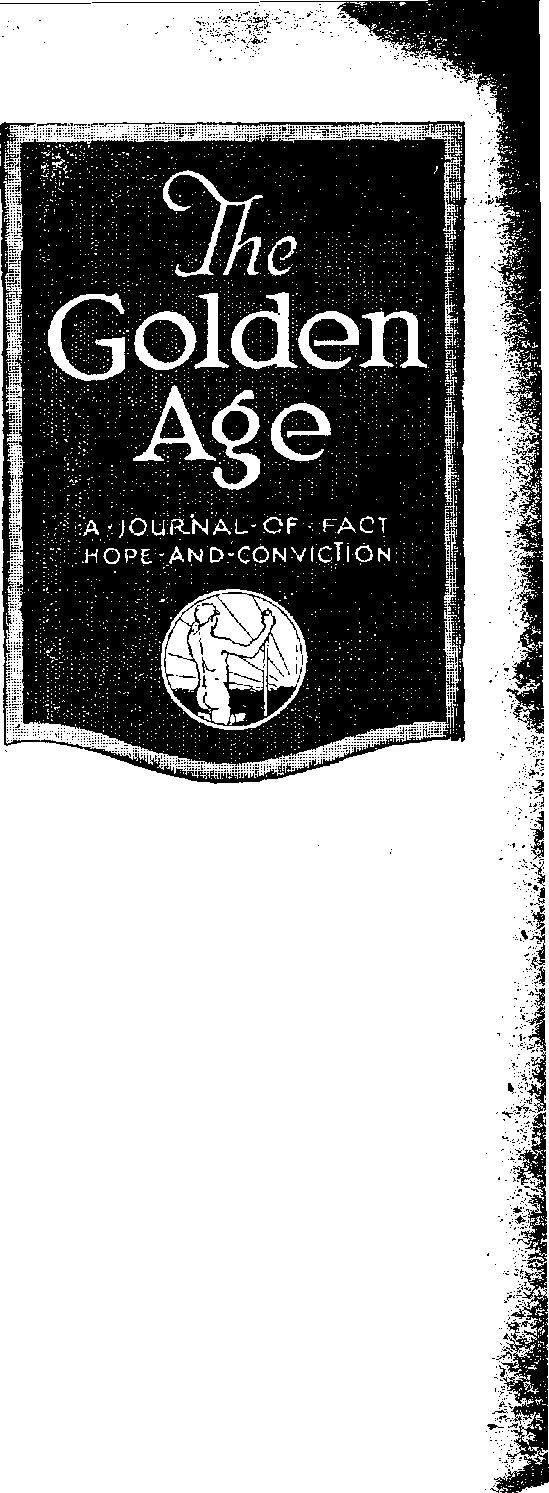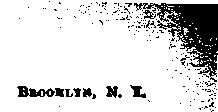The content displayed below is for educational and archival purposes only.
Unless stated otherwise, content is © 1922 International Bible Students Association

Sept 13,1922, Vol. Ill, Na 78
1™J| Published every other IrI week at 18 Concord Street, XjJF Brooklyn, If. T., U. S. 4.
Five Cents a Copy—$1.00 a Year
Canada and. Foreign Countries, S1.M


VbU 8 WEDNESDAY, SEPTEMBER 13, 1922 No. T«
CONTENTS of the GOLDEN AGE
ECONOMICS

SOCIAL AND EDUCATIONAL
Only God’s Plan Will Avail .................
Advertising Is not All Waste ......
MANUFACTURING AND MINING
Reynolds Tobacco Company ,................ —
Letter from J. F. Dodge .......................—.......—
Letter from Reynolds Tobacco Company ------------
FINANCE— COMMERCE—TRANSPORTATION
Rich Men Howl _______________________________________._____.......________
Debt ...................................-.............. -----
POLITICAL—DOMESTIC AND FOREIGN
Why a Painless Soldier "Ninety Days for Being
Bonus ____________________________777 Broke!” --------- -----------....780
A Hebrew in Christian Lumbar Camp Life
Florida .......... .770 In Chri.-ii.m Florida
SCIENCE AND INVENTION
to
Visualizing Fulfilled Prophecies ...................
RELIGION AND PHILOSOPHY
Worship of Demons 787
the False Promised Seed 789
False Chronological
Pagan Origin of
Nicene Creed ..——^....791
Mexican Deznonism ..........793
< 'arricsH Inaccuracy ..........795
Pnb'lisbi-d every other Wednesday at IB Concert Street., Brooklyn. N. T.» ... V. 8. A
by WG0DW0BTH, IH’bGlNGS and MARTIN CLAYTON J, WOOnWORTH.......Editor
ROBERT J. MAH TIN .... Business Manager WM. F. HUDGINOS......Sun’y.nnd TreM.
Copartners and proprietors, Address: 18 Concert Street, BtMclyrt N. V., . . . U. S. A.
Frvr a Cow—11.00 a Year
Forj-tiGN orinc-ES : Jiritish ; 24 Crnven Ten-acp, Lancaster Gate, London W. 2: rnwadMn: 270 Dundas St. W,. Toronto, Ontario:
Collins St.. Melbourne, Australia.
Make remittances to The fJnl^en .40® Entered as second-riass matter at Brooklyn, N, T* Uder the Act of March 3, 1879.
V«luine III
Brooklyn, N. Y., Wednesday, Sept. 13, 1922

Number 78
VALUE is a term applied to the usefulness, or possible good to be derived from things. Considering the diversity of product and other things having value properties, the various qualities that make them valuable, and the separate relation each value bears to living, and thus to life, it is useless to look for a common scale that will measure all value. We hear money spoken of as a measure of value, but not seriously; for every one knows that money can no nearer measure value than does price, and we are fortunate to find price even in the same column with value. Then, too, we have many values that are priceless.
We once thought work could be made the measure of value, i. e., each article of product should be given a price to equal its labor cost, but we found that the value of finished products did not graduate with the value of the labor used in their production, that often it cost as much or more labor to produce inferior as to produce the better grades. This is especially true of natural products, such as coals, wood, lumber, ores, oils, minerals and fish. In most cases, we think, the better the grade of material worked the lower will be the labor expense.
If we would use one hour of standard labor as a “measure of value” we would expect that unit to measure the same value at all times; but does it? One hour of standard labor spent in the production of the best grade of coals will produce three times the value that it will if spent in low-grade production. This is proven by the B. T. U. tests of the respective grades. To measure value wherever we find it would mean to be able by some rule or guage to divide it into equal units of usefulness or pleasure, as by measure we divide other things into equal amounts.
VALUE OF FOOD
In edible products our chemists separate the different properties; tests are made by the properties being taken into the human system, or that of animals. The effects are experienced or observed ; the animation or depression of the person or animal is noted by the one who tests. We learn the properties, but not the amount, of food value. Does it remain for us to measure the animation, the pleasure of health, of palate and of other pleasing sensations derived from these properties, by meters of enjoyment, meters of comfort and meters of contentment that make up the value of a meter of life?
Life is the value dependent upon and sustained by the combined value of all values. Each organ of sense or faculty of the mind adds its value to life in proportion as it harmonizes with the others, and with them together images the great mind of Jehovah.
Have we measured value? Do we know or can we measure the value of good advice, a cubic yard of air, a gallon of water, a pound of wheat? Can we even compute which is of the most value? We know that each ministers to life, but to what degree? What is the amount of this value? What is the whole value of life? Can value really be measured? No! We have traced it beyond the limit of possibility. There is nothing with which to compare. The values of all things are in proportion as they minister to life, and the value of life is in proportion as it resembles that of its Creator.
While the capacity of products for service may vary but slightly, the imperfections of being and conditions hinder us from receiving their full service; so the value of product to mankind fluctuates according to the ability and capacity of each to receive it. Under perfect conditions the full value of things would be enjoyed by all.
But supposing we could price things according to their true value in respect to life, there would be no profit in living. The cost would

772
equal the value. We fear that there is a small margin of profit in life under present conditions for the majority.
The important thing in price-making is that each receive equal and the most value possible for the labor expended. By pricing wood and coal per standard heat unit, edible products per standard food unit, textures per standard service unit, etc., price would graduate with the number of value units an article contained, and the only thing left would be to start all prices on the right level.

Brookltx, N. I.
prices, and then regulate the supply at market centers to a reasonable store that will take care of demand when it comes?
We find no way that supply and demand could, or evidence that they ever have, or now do, rightfully function in price-making. Even in case of shortage would it not be better to prorate what we have, than, by high prices, to limit it to one class and change the buying, power of the wealth of the whole nation? How can we graduate prices with both supply and demand at the same time? Think it over.-

SUPPLY AND DEMAND
If prices fluctuated only to the extent that the nation’s supply varied from normal, there would be no extreme changes, and they could be approximated in advance; but when demand, which is always erratic and unsteady, becomes a factor and the receipts and supply at terminal points, in place of the total supply, governs, prices become very unstable.
But the real oscillator of this price-making machine begins when the belt is switched to the guess-work attachment of future supply and demand at home and abroad. This intricate mechanism is so sensitive that the report of a flake of rust in Dakota or a rain-cloud in Kansas will start the indicator up or down a half dozen points. Its main purpose seems to he to keep prices on the jiggle and the swing so that each operator, as it comes his way, can take his toll.
Consumption may be practically steady, the total supply normal, and yet demand may fluctuate wildly. Some days, by force of circumstances, either receipts or demand may be excessive, or practically nothing. And when the year’s marketable product of an individual depends on a price determined by the supply and demand of a day or a week the possible injustice is enormous.
Every one knows that it would be good policy for the nation to have from one to two years’ supplies ahead, and if it did so, is there one good reason why that should affect prices ? Or if the demand varies from week to week is there any reason why prices should follow? Suppose prices could be made to graduate with the amount of surplus product on hand; is there anything about the workings of supply and demand to indicate the level on which prices should start? Would it not be better to determine a fair price-level and establish
LABOR COST
There are several reasons why labor expense and not value or supply and demand should be used as a base for price. While in character, labor is variable and unsteady, its results depending on intelligence, training, skill, and application, yet it can readily be standardized by ascertaining the length of time required at fair speed to perform a given * task; and thus there could be established for each article, or service, a standard labor-timerequirement, the laborer to be paid according to whether the actual time used was, or was not always the same.
This is similar to what is called the "piece work system,” only the time feature should be retained, because time will graduate with mon- • ey and is useful in computing prices. Then by giving labor a standard price per standard labor-hour, product would be given a standard labor expense expressed in terms of money, ' which would be a base for standard product ! prices. ‘
But the real difficulty in making prices is where there are several grades of a product, , each carrying practically the same labor cost, ■ or where several products, as woolens, cottons, and linen, compete for the same use. It is evident that in such cases prices should follow grades or value qualities. The only way we see j that this can be done with equity to all is by .
pricing the low grade article of each class at -
its labor cost, the others as much higher as their grade would indicate, the difference between labor cost and selling price to go into a fund for the common good; the producer to receive labor cost for his product; the distributor to receive an equal wage for his standard I labor time (figured on percentage, mileage, or J otherwise); the price to the consumer (both J
September 13, 1922
producer and distributor) to include the entire cost plus the excess value.
This excess value, as we have seen, is unearned increment and belongs to all and should be used in lowering expense; thus all would receive equal pay for their labor and labor equivalent for their money. The raw material on which no labor has been expended should belong to the people; the only rightful expense is the labor cost from the ground up to the delivered goods; the money received by the producer for his product and the laborer for his work should represent the share of labor each has contributed to the delivered product. Any change in the buying power of that wage by pricing goods on any other level is an injustice.
So we conclude that prices should be based not on value, but should graduate with value, and start on a level as low as will cover the labor expense of the low grade article of each class of product; that product should be standardized by being tested, graded and priced, and to prevent fraud, wherever practical the goods should be stamped with the labor cost, grade, and price. Then the price itself would be an index to value.
MONEY
It is claimed by some that there is not enough money in the world to pay the world’s debt. Some attribute the cause of our indebtedness to a contracted fiscal system or to the gold standard. The fact is that the tendency is away from the use of money except as a base. We write the large amount of our medium and we sometimes wonder if our banking will not become entirely a matter of crediting accounts.
This could easily be done by depositing all the money in one bank, say at Washington, D. C., the accounts there to be kept in the name of states, the state accounts in the name of counties, and the county accounts in the name of local banks, the local bank to keep the personal accounts as now, and report the trade balances to the county bank, the county balances to be reported to the state, and state balances to Washington. The business could all be done by wire or wireless, and no checks or drafts used excepting at the local banks, or possibly, in traveling. This, however, would in no way increase or decrease the making or liquidating of debts, but is stated to show that,
•' -'-/is
with our system of checking, every individual in the nation could transfer his entire credit in a day without being hampered by lack of '4 currency.
The ability to pay debts depends on the earner’s balance left after paying living expenses, taxes on his property, and interest on his ob- * ligations. As long as the system in vogue multiplies his expenses to the amount of his earning power, the volume or kind of medium in use, if it passes at face value, can have little e fleet.
Profits increase the cost of living. Interest and taxes consume the earnings alike under the gold standard, the commodity standard, or the product standard. Interest rates can be effectively lowered only by supplying the people with the free (not unsecured) use of money, living expenses only by pricing product so as to eliminate profits, taxes by spending less for expenses and improvements.
Tin* free use of money is not uncommon, but at present the banker gets most of it in bank notes from the government and deposits from the people. I hold that it is unreasonable and unjust to be obliged to furnish security to private individuals or banks and pay for the use of public currency thus secured; that real estate and other values should be stabilized in price according to labor cost of construction, and productiveness (provision being made for their upkeep) and a system adopted by which the owner could issue stock to be used as government bonds are used in securing currency at the county offices where the records are kept; that money should belong to the government and be kept completely under its control; be passed out only in payment of product or other values to be held until the market absorbs them, and then the currency retired; that our money is as good as our bonds; that any government or public obligation should be paid by issuing currency and taxing it back. Under such an arrangement we would at least have the advantage ( if any) of inflation while the debt lasted and would save the interest, which gent*rally amounts to from one to four times the principal.
The value of money is equivalent to the value of the product it will buy, and is determined by the price maker; its value can be stabilized by, and only by, standardizing the price of product and other values; business

774
can never be fairly conducted as long as the buying Value of money changes.
If necessary to supplement gold as a base for currency, stabilized product or other values are superior to government bonds, as there would be no interest to pay, and a nonfluctuating value would be on hand at all times to redeem the currency.
Usury and profit are responsible for our financial troubles; if their practice is continued the common people will be reduced to serfdom or, if they refuse to lower their standard of liv
ing, dur organization of society will be wreek-t ... ed. Usury and increase are against the Bible
r teachings, and all sound business principles,
. and are doomed to destruction. We can have E; no Golden Age as long as such practices exist, [ but only after their abolishment.
When a practice is found to be wrong, the time has come to rectify it. If our money is used to curse society with a burden of interest, profit, and rents, we should change its use. We are glad to know that the “kingdom of heaven” - is at hand and soon these things will all be righted, but we believe much trouble, misery and a possible reign of anarchy could be avert-ed if we could apply the remedy at once. The question is, Have we as a nation sufficiently ? learned our lesson or will we fight righteous dealing to the last trench? The wisdom of our Lord and King will decide if we must drink this last cup or whether, by the further shortening of the days, it will be allowed to pass from us.
RICH MEN HOWL

“Come now, you rich, weep and lament over those miseries of yours [righteous Government with restitution] which are approaching. Your rich stores have decayed, and your garments have become moth-eaten [Why? Because the wages of the common people are not sufficient to buy the product they produce]. Your gold and silver have become rusted [depreciated in purchasing power] and [that very fact] the rust of them will be [is] for a testimony against you and consume [consumes] your bodies like fire. You have laid up treasure for the last days. Behold, [those treasures] that hire which you fraudulently withheld from those laborers who harvested your fields [in whatever line] cries out [the riches themselves speak loudly that the laborer has not received his full wage] and the loud cries of the rea pers

pHOOKLTN, N. T.
[laborers everywhere] have entered the ears , of the Lord of armies of all.[Young’s Concordance]. You have lived luxuriously on the [fat of the] land and been licentious. You have nourished your hearts [with big profits and graft] in a day of slaughter [the World War]; you have condemned [to prison]. You have murdered the righteous One [and the members of His body]; He does not oppose you [but has provided for you a way to eternal life, the joy of which even for one day will far exceed your riches].”—James 5:1-6, Diaglott.
DEBT
Debt is the result of one side of a bargain, interest-bearing security the result of the other. Debt of itself is not so much an evil; but there are so many attendant evils that its practice is inadvisable. The tendency to make unnecessary debts, to avoid the payment of those contracted, to take undue advantage of the debtor, the inability always to pay as agreed, and the increase of debt by accrued interest are evils that possibly cause more litigation than all else. Debtors might be divided into three classes: Those who are allured into debt by prospective profit; those who buy homes on time; and those who, because of misfortune and necessity, are forced to borrow.
Buying and owning homes are praiseworthy and should be forwarded in every way possible. At present there are many draw-backs to home-getting: the speculative value of property renders it unsafe as security for more than fifty percent of its ordinary selling value and this necessitates a cash payment of one-half, at time of purchase; interest rates on the balance are high, and taxes are high. If in the city, street improvement assessments are high, together with water and light bills; then there is always the danger of sickness or other cause to diminish or stop the income, which may result in the loss of all that has been paid.
Under these conditions many a man has paid in rents or interest time and again for the property he occupies, and in the end found himself in the street. War, with the prospect of scarcity, increases prices; as they begin to soar, the incentive to speculate grows; values change hands at increasing figures until both capital and credit are reinvested; the lack of confidence in the future to sustain the higher prices checks the investment of capital in that

September 13, 1922
direction; the heavy interest becomes a burden; and people awaken to the fact that property is worth no more to use than ever.
Only by dint of imagination can we lay the blame other than to the get-rich-quick incentive of the speculator. Debt starts to increase with prosperity, runs with it neck and neck, and outdistances it at the wire. Speculation is the child of price fluctuation, and the two, without flowers, should be laid in the same grave. Men buy houses and land to speculate on and keep them from those who should have them for homes.
Of what use would be an extra farm if the man who rented it received the cost of production for his labor and his product sold at labor cost? Or if the hired man was paid on the basis of labor cost of production, where would the owner get any thing — and why should he? Working at a profit more land than a family can tend to is speculating in labor.
Things priced and sold on a labor-cost base would limit the earning power of real estate and other values to the amount necessary for their up-keep, and would prove no incentive to own more than a home, and the land that could be worked to advantage by the family.
Standardize the price of values on a basis that will make them safe security for stock to the amount of their full valuation; then let the purchaser deposit this stock or any part of it, for a limited time, as security for currency, the same as government bonds are now used. Rents and interest will be eliminated and the home question forever settled.
Either speculation, the desire to own a home, or necessity, gets us into debt; high living cost, interest, and taxes keep us there and encourage others to pay high rents rather than to obligate themselves by buying homes. Because ofi the evils of rents, interest, and profits the vast majority of people are slaves. A panic now and then to cripple investments, also helps to keep the rent business good. That people are shiftless, bad managers, live or dress too well, are reasons given for failure by those whom fortune invites to have softer seats. These reasons contain the usual grain of truth with the pound of error, but the last analysis shows that under our present lack of system one class can be highly prosperous only at the expense of another.
Wages of Workingmen By John Buckley
THE following advertisement appeared in a
Sunday paper recently: “Wanted: College man, five years out. Salary $25.”
The great majority of workers in the United States earn less than five dollars per day. I know one college man that is supporting a wife and four children on thirty dollars per week. The office man or clerk, working for a salary, knows what his income will be. The laborer, factory worker or mechanic knows that for each day lost, whether it be a holiday or because of unavoidable sickness, he will be docked.
The masons, plasterers, carpenters, and other workers at the building trades receive big wages, yet they lose much time during the winter, and few of them average five dollars per ’day. Every effort is being made to bring wages down, and the mine horror at Herrin, Illinois, is but an incident in the. struggle for an existence. The cost of food has been greatly reduced, as have some other necessities, yet the general cost of living is as high as it has ever been; the increased cost of housing more than making up for other reductions.
It is impossible, in our cities, to find a tenement at a price that a man with a family can afford to pay. The man who gathered the rags at my door yesterday is paying fifty dollars per month for five rooms.
Can race suicide be wondered at when each additional room costs ten dollars per month? You cannot put children, like kittens or puppies, into a basket. In addition to the housing, they must be fed, clothed and kept warm. Our laws will not permit of child labor; and until the school age is passed, children are a heavy burden. Many a man will drink, that he may forget his worries, which only increases the trouble, and in despair he becomes a derelict.
A short time ago I heard a man say that only fools and horses worked. A reversal of the Golden Rule to make it read, ‘Do others as they would do you,’ is being more often adopted. Formerly, it was thought good policy

Tt6

SuMKizrir. N. ■ ■ s
g.
F-
-■
to believe a man honest until he has proven to be otherwise. We have become a business nation, however, ami business men take no chances. . The present housing shortage is forcing many working people to buy houses, even at the present inflated prices. Interest on the mortgages, high rates of interest, high taxes, insurance, and other expenses, will keep them perpetually hard up. During the business depression of 1875 and 1876 many working people lost their homes. One man offered a brick house to a friend of mine, if he would assume the mortgage.
Two of the directors of a local savings bank bought a large number of homes that were foreclosed by the bank at much less than the face of the mortgage. The bank lost money, as did the owner of the property. The directors gained and, in two years, the property could be sold at its full value.
Speculative buying of farms during the war was opposed by the Government and, with the present low prices of food stuff, many buyer's wish that they had no farms. So troubles aro not alone to the city man.
The man who sees the little that he has struggled to acquire taken from him, and who sees his family suffer for the necessities which he is unable to provide, will become hard and bitter. ‘To him that hath shall be given,’ is taken literally. He has seen it work out, and he is blinded to the goodness and to the mercy.
Divide the workingman’s daily pay of five dollars by his needs. Take from it the fifty dollars per month for rent, or the fraction that would come from five dollars. Divide what is left by six or seven, as the case may be, and then figure for yourself how long it would keep a person at a fashionable hotel, or at the seaside. The prevailing conditions neither stabilize the Government, nor promote nor encourage honesty, nor make Christians.
K ‘ ; ------
& Only God’s Plan Will Avail By T. II. H. Messinger
THE Golden Age articles on the present situation in the world are helpful to me as confirming more and more the things written aforetime for us. They carry me back many years; I am now past the threescore and ten mark; but recall when at the age of fifteen I began to search the Scriptures and at the age of twenty, while working among my fellow mechanics, I began to study with others how happiness could be brought to us all. Then after arriving at the age of twenty-one I got into politics and fraternal organizations to try to help solve the problems of life.
Alas 11 saw that envy, covetousness, and selfishness were deeply imbedded in mortal man, and even among church members it was about the same. I saw, as one expresses it, “Man’s inhumanity to man makes countless thousands mourn." Among my fellowworkmen those who cried out the loudest against oppression, as soon as they were elevated to positions above their fellows or got into business for themselves, were the worst against their fellowmen. The workman’s worst enemies were from his own ranks, and even the pledges and oaths of the fraternal societies, or the teachings of the churches, were ignored by a large majority.
Having a clear awakening to this in 1878 I turned to the “Old Book” as the only place I could find any explanation of these things; for I knew it said, “Man is prone to evil.” As I searched and dug into that Word the light began to shine and has continued to shine brighter and brighter as the Day is gradually approaching. I saw by faith through the Word Jehovah’s wonderful provision for the restoration of mankind; the return of our Lord and the setting up of Messiah’s kingdom.
How that Government was to be adminstered. on this earth by our Lord and His body was still not clear to me; when in testifying of my hope to one, he gave me a little book (“and I did eat it”), called the “Divine Plan of the Ages,” by C. T. Russell, and here I found pointed out in the Scriptures the “missing link,” which I had failed to find. So I praise the Lord for using the clay, our beloved brother, to anoint my eyes, to show me how I might wash in the Word and see; and as time goes on and I still search the Word the day is growing brighter and brighter, while the condition of things in this old world, as pointed out in the Golden Age, seems to say, “The kingdom is at the door.” May our faith increase at the prospect!

.4s-‘

THE possibility of a soldier bonus might be more favorable if Congress possessed a
Urim and Thummim.
A bonus for the ex-service man has created a political sensation that almost rivals any in the history of our nation. Congressmen, in order to retain their positions, feel that they must do something to slightly compensate the men who sacrificed all during the months this nation was engaged in barbaric warfare to fight for “Democracy.” But if one extends a helping hand to the ex-service man and thereby imposes an additional tax upon the already overburdened tax-payer, his job will be just as insecure. So between the soldier vote and the tax-payer’s vote, the congressman is left wondering as to the best way of escaping the dilemma and sustaining the least injuries.
Property owners who had no direct participation in the war would be glad to lavish an appreciable gift on the men who fought for them, if only they could do this without draining their own pocket-books. We are moved to raise the question: Why make the bonus a painless one, when we reflect that the war was not painless? It goes without saying that many of the almost generous tax-payers, who so vigorously opposed the Bonus Bill, did not hesitate to call a young able-bodied man who was inclined to procrastinate before joining the American forces during the war a “slacker,” with a Dempseyfied emphasis on the term.
Have they forgotten the horrors of war? When we note their conduct of the past few months we are compelled to declare that they have never been acquainted with the concomitants of war. No American citizen mentally normal will say that war is a pleasure. If there are a few who still grope in darkness on this question, then let us cite, for the benefit of such, only a few of the maladies caused by war, that greet the eye every time one appears in public. Look at the thousands permanently confined to government hospitals as the result of almost fatal wounds. Others are left to contend with the direful effects of poisonous gas. Many thousands of precious human organisms are maimed and, worst of all, must remain that way throughout the rest of their lives. Daily we have with us men in the prime of life who have to depend upon crutches, wheel chairs, and other accessories. Why? Because they were loyal to their country; because they were will-
ing to do their utmost. When called upon te leave home, job, friends, and all the pleasures the civilian life has to offer, they went gladly (excepting a few, the “C.O.’s”). They went with the determination to make this world a fit place in which to live. For themselves only? No! For everyone.
Now let us propound a simple question. Is the man who was not called upon to render his services on behalf of the nation during the war just as willing to pay a few cents more per year ou his taxes and thereby extend invaluable aid to the man who did go, who fought and returned and is now left without a position whereby to provide the necessities of life? Most emphatically, No! At least the recent discussion upon this perplexing question has led us to this conclusion. Why should not taxpayers experience some of the horrors of war themselves? During this international conflict many, yea all, reaped financial rewards heretofore undreamed of.
Ex-service men do not call upon any American citizen to pack up and leave home, family, friends, and good position, nor even such a trifling thing as a pleasure trip. Yet they did it, and never even murmured. No! None dared to murmur. To do so meant a ten or twentyyear vacation at Atlanta or Leavenworth. But the penurious tax-payer can say what he pleases against the Bonus Bill and none shall bid him hush. His arguments are heard and weighed in the Senate. But a poor conscript’s argument (if he dared to divulge his opinion) was heard only by his bunkie in the guard-house, provided he spoke in a sufficiently low tone so as to keep the prison guard from hearing what he had to say.
It is high time for ex-service men to oppose this procedure. Every man must divulge his opinion. He must speak now as he was spoken to during the war, if he seemed inclined to lag behind. The nation demanded a supreme sacrifice of these men. Now they must demand this insignificant gift stipulated in the Bonus Bill.
If our rich Government maintains that it is-too poor to spend four billion dollars for the relief of ex-soldiers, then let employers at least restore them to their former positions. We are inclined to view our national poverty as a camouflage when we take into consideration the fact that Congress has appropriated millions 777

778
Brooklyn, N.
upon millions of dollars for the construction of battle-ships which after a few years in active service were dismantled to be used as targets for naval aviators to demonstrate the practicability of naval airplanes.
Let men at the head of this mighty power curtail expenses by using cheaper targets, and not refrain from partially paying their indebtedness to the army of heroes by “shelving” and eventually “killing” the Bill.
Reynolds Tobacco Company
WE ARE glad to make correction of an error which appeared in our columns respecting the Reynolds Tobacco Company. Mr. Barnes, the writer of the article in which the error occurred, is generally very careful in respect to his statements of facts, but in this instance was deceived by the clever maneuvers of an unscrupulous salesman for other tobaccos. We have in hand a statement of the facts by a gentleman who lives in the city where the Reynolds plant is located. We guarantee its accuracy and reproduce it herewith, followed by a letter from the Reynolds Company bearing upon the same matter.
-T/?’ f'/l,
Letter from J. F. Dodge
Mr. Editor: I was surprised to see in No.
76 of your interesting magazine the following statement:
“The R. J. Reynolds Tobacco Company has closed its doors to all Protestant help. Protestants, therefore, are boycotting all tobaccos and cigarettes bearing the R. J. Reynolds tag. This includes some of the most popular styles such as Prince Albert, Camels, R. J. R., etc. Large shipments have been returned and orders canceled, it is stated.”
In normal times this great industry employs some 11,000 people. It makes no religious test when employing new men. It is probable that in this city of some 50,000 people there are not 200 Catholics and more than half of these are Greeks and Syrians, who are not Roman Catholics, but Greek Catholics; so that, while we have ninety-nine churches in the city, only one, a small one, is for Catholics, and I understand that both Greek and Roman Catholics use this alternately. Thus it will be seen if Protestants were barred they would not likely have more than twenty-five or fifty people to run this great business.
Now, of course, Mr. Barnes believed that this statement was true, and so I am inclined to think he lives in a city very largely of the Protestant persuasion: for if he lived in a city in which the Catholic element predominated, he would probably have written that this great company had closed their doors to all Catholics. My reason for thinking this is because competition is so sharp these days that the salesmen of competing tobaccos and cigarettes have a systematic method of telling in a city largely Catholic that Reynolds employs only Protestants, and in a city largely Protestant that he employs only Catholics, in order to kill the sale of Reynolds goods and to place their own instead.
A short time since one of the labor organizers received a letter from the far West, asking him if it were true that Reynolds would not employ any Catholics and stating that if so he would cut out these brands in his business. The organizer took the letter to the office of the company and handed it to one of the officials, who, after reading it, smiled and from a pigeonhole in his desk took a letter and handed it to the organizer. This letter roasted the company because of antagonism toward Protestants in the conduct of their business.
Mr. Barnes should be careful to have proof of his statements before sending them in for publication.
I am sure you will be glad to correct this statement; for your magazine believes in doing justice to all, whether their line of business is objectionable to you or not.
Letter from Reynolds Tobacco Company
Dear Sirs : On the 15th instant we wired you as follows:
“In your issue of August 16th you publish the statement that this Company has closed its doors to all Protesiant help. This statement is absolutely false as are also the other statements in same paragraph relative to the business of this Company and we are putting you on notice that we expect to hold you account- :: able for the publication of same. Wire us what you expect to do toward correcting these statements.” y

And we have received your wire of the 16th instant in reply as follows:
“The author of article referred to in your wire not here today. Investigating facts. Will advise you later. If we have done you an injury we will certainly take every step to retract. Please write us facts and we will publish the same. We do not wish to misrepresent you.”
The statements referred to in our telegram appear on page 714 of your issue of August 16th, 1922, Volume 3, No. 76, which are as follows:
“The R. J. Reynolds Tobacco Company has closed its doors to all Protestant help. Protestants, therefore, are boycotting all tobaccos and cigarettes bearing the R. J. Reynolds’ tag. This includes some of the most popular styles—such as Prince Albert, Camels, R. J. R., etc. Large shipments have been returned and orders canceled, it is stated.”
This statement contained in the above quoted paragraph is absolutely false and without foundation. This Company’s business was built upon open and above-board methods; in other words, fairness to all. No employe, from executive officer to the most unskilled laborer, is measured by uny other standard than merit and no one of them has ever been favored or discriminated against in the slightest degree because of his political, religious or fraternal affiliations; nor has this Company ever been influenced in the slightest degree in giving or refusing employment to any person because
of such person’s political, religious or fraternal affiliations. ..... ..
You disclaim an intention to deliberately misrepresent us and state that you will investigate the facts and advise us later. The most casual investigation would have disclosed the absolute falsity of the statements published by you and it is amazing that you would assume the responsibility of publishing them without first assuring yourselves that they were correct. Ordinary fairness demanded that before publishing these statements, affecting as they do the business and reputation of this Company, you give us the opportunity of proving their falsity.
We note that yon are willing to “take every step to retract.” This is the least that, in common fairness, yon could do towards correcting the damaging impression which the publication of these statements is likely to create. We assume that this retraction will be full and complete and published in a conspicuous place in your publication. Please send us a copy of same before you publish it.
Awaiting with interest your report as to the results of yotir investigation, also the publication of your retraction we are
Yours very truly,
R. J. Reynolds Tobacco Company.
A Hebrew in Christian Florida By Isaac Herman Schwartz
I HAVE read of the cruelties perpetrated by Arabian slave-traders on their unfortunate victims; I have heard and read of hardships forced upon and endured by American Negroes before the Civil War; eye-witnesses have recounted to me what they saw and experienced in dreary Siberia in the heyday of Czarist misrule—but my most venturesome fancies never approached the experiences I have lived through last year in “free” and “democratic” America.
In October, 1921, I found myself in Mobile and in the position generally described as “flat.” The economic crisis of the period prohibited any encouraging thought suggestive of “seeing it through,” so the painfully obvious thing for me to do was to move on—via the side-door Pullman. I remembered having friends in the city of Jacksonville, Florida, and decided that I could not do better than remain in that city until winter was over.
I had heard much of the “Land of Flowers,” good and bad. Especially had I been told to beware of the deputy who leads the penniless stranger and hobo right into the very heart of Florida’s pride—-aye, even into the midst of the verdant but swampy lumber camps. But I put all these admonishings down to the contrary tastes of these individuals and blithely hopped an east-bound freight.
Sunday morning, October 30th, I had gotten as far as the division called River Junction, Florida, and fairly close to Tallahassee. Having seen neither hide nor hair of the deputy I had been cautioned to beware of, I decided that the hoboes had exaggerated conditions here; and hurling caution to the fragrant Florida breeze, I clambered out of the refrigerator
an


car I was riding and seated myself on its roof. But something occurred to disturb my appreciation of Ponce De Leon’s discoveries. For shortly after leaving River Junction one of the train crew approached me with a demand that I “come across” with two dollars. I informed him that I felt greatly embarrassed at his demand, for it was manifestly impossible for me to raise the amount asked. I had but a quarter and kept it tied in my bandanna for fear of losing it.
“Hain’t you even got a dollar was almost sympathetic.
“The most valuable thing I’ve got is my labor card,” I smiled. “And it’s a red one,” I added with grim emphasis on the adjective descriptive of Ab.p first color in Tie spectrum.
“Cain’t honor ’em,” he whined. “The rest of the crew’d git sore—red or white cards. You’ll have to get off at Tallahassee—cain’t hide you for nothing.”
I saw him look into other cars and apparently talk to other knights of the road. But disappointment clouded his countenance, as he made his way from them to the caboose. Evidently this was not a very lucrative trip.
A few moments after he had gone I was surprised at the sudden appearance of a man approaching across the tops of the cars from the head-end of the train. Something about Ins appearance was at once unpleasant and disquieting. Ue was too well-dressed to be a trainman. When within ten feet of me he lost no
oners to communicate with each other vocally. Facilities for personal sanitation and hygiene were most primitive. I was grimy from head to foot from the train ride, and asked the jail- ' er's son (who does his father’s work before and after school) for some soap. But he was two days in getting it. '
Il is voice to our colored neighbors in the cells beneath
As no towel accompanied the soap, I used 1 my shirt to wipe with. Three auto thieves and two hoboes were the white prisoners we found at the time of our entry; and by calling out ns we learned (hat their number consisted of four persons, including one who said his name was “Sam,” and who was a frequent guest of the county because of his penchant for “devilment.”
The following morning we newcomers were tried. The judge, the deputy and we four hoboes were the only ones in the courtroom.
“You were all caught riding the same freight, so there is no difference in your cases. The offense and penalty is the same in each case. You’re each lined twenty-five dollars and costs or ninety days,” was the judicial decision, delivered so soberly that it made me smile.
“ninety days for being broke!”
“Ninety days for being broke!” exclaimed one of the ex-service men. “Some court!”
The dope-head entreated the judge to send him to some hospital where he might be cured. He exhibited an A. F. L. Boilermaker’s union
time introducing himself; for he whipped out a long-nosed “lead spitter”; and ere I knew what was happening, a pair of nickel-plated “bracelets” adorned my wrists. “Don’t try to get away,” cautioned he, as he started for the next car. I though that I could be just as funny as he; so I retorted that I would not try to get away after trying so hard to get thus far.
He found three other hoboes. One, it later developed, was a hopeless drug addict, and the other two were young ex-service men.
Arrived at the station in Florida’s capital, we found a goodly portion of the native populace assembled to greet us, from which we gathered that the daily arrival of the freight train is quite an event in Tallahassee.
The sheriff’s auto conveyed us to the county jail. The first floor is for Negro prisoners and the second for white culprits. The cell and the jail construction is such as to enable the pris-card and begged the judge to interest local unions in his case. The judge promised he would; and the following day a local union man came to the jail to see the drug addict. He talked with the unfortunate a while and promised to “see about it,” but never returned.
Two meals a day are given the prisoners here: at 8 a. m., and 2 p. m. The first consists of a little grits, a small slice of bacon and two biscuits. Every other morning two tablespoonfuls of syrup are added. Tea and coffee are but memories here. Dinner consists of a few ounces of black-eyed peas, a small piece of fat pork, and a small piece of corn bread. The bill of fare is changed Sunday, when beef stew is given for dinner with a little meat.
When the meals were “served” we four newcomers were astounded at the behavior of the other prisoners. When the food is brought the men are locked in their cells; and after the at-

tendant who brings the food returns to the outside corridor, the cells are opened simultaneously fn in the outside. When the doors were opened the five prisoners whom we had found in the jail when we were first brought in, would make a dash for the food—even stealing the miserable contents from each other’s pans. We newcomers held an “economic” conference, at which it was decided that whoever went after his food at a pace greater than ordinary walking would receive a good lacing—the law to go into effect from that day on. We made our decision known to the others, and it is sufficient to say that we never had to administer punishment as long as we remained in this place.
By this time our number was increased by five—all hoboes. One was a mere child of fifteen, and another a man of middle age. The remaining three were young men, of whom two were fortunate in receiving money with which to pay their fines.
. One night about the middle of the week I
was roused from slumber by sounds as of t weeping. The sobs, mingled with an occasional
i groan, came from beneath—from some Negro , prisoner. A quarter of an hour later the man’s
■ weeping ceased; and he began praying softly,
t in that simple child-like manner so typical of
> the southern Negro. After a half-hour of
; prayer, with mingled sobbing, everything grew
u quiet again and I fell asleep.
s Before breakfast the Negro, whose name was
1 Sam, called up to us entreating us to be quiet.
I We asked if any one was sick; and he told us ? that a prisoner by the name of Ned Thomson ; had died during the night. We urged him to
tell us something about the prisoner; but all f that he would say was that the man was re-» turned from the “road” too ill to work.
I Our blankets were so lousy that one of the
hoboes almost wept from the torture of continually scratching. We raised a disturbance; and when the jailer’s son made his appearance we demanded some disinfectant and an atomizing gun. He brought these not so much to please us as to prevent us from making any more noise. We set to work and annihilated some billions of “cooties.”
All the prisoners were given a “medical examination” to determine where each should be h. , sent to work out his sentence. The “doctor” f ... proved to be a humorist; for his examination
t , consisted of the sole question: “What’s the
781
matter with you?” If no deformities were apparent and the prisoner was able to walk, he was sent to slave in the lumber camps. AH the ■ rest—and there were few—went to build roads. ■
I was sent to a lumber camp the ninth day ■ after my arrest. First the sheriff drove me in a Ford thirty miles from’Tallahassee to a town -called Perry. Here I remained in jail until ; after dinner. I had one cell-mate, one of Fiori- . - , , da's native sons. To make conversation I asked him why he was imprisoned.
“Oh, nothing much. I jes’ killed a good fer nuthin’ feller in self-defense.” He went on to explain that feeling ran high as a result of his exploit and that a few weeks after his arrest the friends of the dead man assembled about ‘ the jail in anticipation of a “necktie party.”
“As if I was only a dern nigger,” he added, the indignation of injured race-pride flashing from his eyes. “But, you know,” he confided smilingly, “my wife told me afterward that there wuz ten of my frenz to one of his’n; so there wouldn’t have been much of a battle.”
LUMBER CAMP LIFE
The talk turned to my case. He grinned. ‘‘You shore landed in hell, son,” was his comment. Even if you’d paid the trainman those two dollars he wanted, you would land here just the same. They are all in it and get a rakin’ off from each man caught. There ain’t a man in three counties around here that ain’t been a guard one time or another. I’ve did it myself,” and here his chest expanded a trifle. He also began informing me about the lumber camps. The prisoners are hired out to the Putnam Lumber Company for twenty dollars each. The Lumber Company has complete charge of the men and has its own guards, who are very brutal.
“They don’t hesitate none to pull the trigger, bud,” he continued, “’cause that’s the orders an’ if you make a move that looks like it smells siispeecious, the chance is that you’ll be buried in the swamps that night. The guard shoots in self-defense, you know,” and here he gave me an eloquent wink.
“I’ve seen men whipped till they had to be toted to the stockade,” he went on enlighten me.
“But why?” I asked, greatly puzzled.
Sympathy for my apparent ignorance showed on his face. “Well, for one thing, to make

*
782
n* GOLDEN AGE

Brooklyn, N. Y.
*
’em scared; and ’nother, to get all the work out of ’em that they can. A six-months sentence means that a man will be worked within a quarter-inch of his life. The longer the sentence the less hard the prisoner is worked, ’cause if they works a long timer without a limit he’ll die afore his time’s up and the Putnam Lumber Company loses money on him. You see, you stand a better chance of cornin’ out alive without a broken body if you has a long term. Figgern’ the cost of labor at this time, the Putnam Lumber Company gets about $200 worth of it out of nigh every prisoner at the camps every month for only $20 a month, too. If you was doin’ the same work as a free man, you’d only be getting $1.75 a day.”
Here a disquieting thought entered my mind. “Tell me,” I asked, “are the prisoners permitted to send and receive mail?”
“Well, the camp boss reads all your mail; and if they don’t like what you write, they tears ’em up and you gets whipped besides. You dassen’t complain. Sometimes they writes for you.”
He gave me writing material his wife had brought him; and I wrote a note to my folks to send money for me to be liberated. I read it to my cell-mate.
“You better add thirty dollars to it, ’cause the ride will cost that much. You got thirty miles more to ride. When you’re out of here you’ll be in charge of the Putnam Lumber Company.”
I was thankful for all I had heard; and he promised he would mail the letter for me. At 2 p. m. a man unlocked my cell and commanded me to follow him. He was my guard and drove me in a machine to the lumber camp. It is certainly strange that the creatures of the lumber interests should possess the keys to the jails of Florida; but it is true nevertheless.
During the ride to the camp he asked me quite casually if my people knew where I was; and when I told him they did not, he smiled.
We reached the camp at sundown. I felt slightly ill; for I am a vegetarian and sorely lacked the food I was accustomed to eat. My interior was beginning to register complaints, but I thought it best not to mention the fact to the man I was turned over to at the camp. This man I found out was Captain Higgin-bottom. He is in charge of the prisoners and is the one who does the flogging. My clothes were exchanged for convict stripes. I could eat no supper; for my stomach was in revolt. After supper the men were locked in the woollen stockade which served for jail and sleeping quarters. They crowded about me, telling me that I had come to a veritable hell. They showed me their hands puffed and blistered from the fierce toil they were constantly subjected to. I saw ugly running sores, for the cure of which “salve” was applied. Some had venereal diseases, but nothing was done for them. All were weary in mind and body. Eight of every ten were there for hoboing; and they all swore vengeance on Florida for their sufferings.
“They’re so ignorant here,” a tall blue-eyed Westerner told me, “that they must be run down to have shoes put on them and blindfolded when they are first made to put on underclothing. When I told the guard I was from Oregon, he asked which county it was in.”
Several had been whipped that day and they exhibited their backs—red and swollen.
“One never does enough to suit the hounds,” said one. “From the minute the labor-train dumps us in the woods early in the morning until sundown we must work as hard and as fast as we can. The guards are there to see you do it.”
“The doctor comes here once a month unless someone can’t go to work in the morning. Then he gets here oftener,” stated another prisoner.
A Slav prisoner spoke: “I am going to Russia when I finish here; they don’t arrest you there if you have no money.”
One whose face seemed fashioned in perpetual sneer turned loudly on the Slav: “That’s the trouble with you foreigners. You don’t appreciate a free country like this. Why didn’t you stay in Russia?”
The tall Westerner nudged me in the side. “Look out for the guy that’s squawking to the Rushun,” he whispered, “he’s a stool-pigeon. We’re going to corral him out in the woods one of these days, and then he won’t return to supper. Don’t talk to him.”
“You ought to be thankful you are not black,” one prisoner said to me. “They are treated worse than we are. One named Ned Thomson was whipped even though he could not walk, not to mention work.”
“Ned Thomson!” I almost shouted the name; for it was that of the unfortunate negro who had died in the Tallahassee jail.

“Do you know him?” they asked, assembling about me.
I, told them what I knew of the dead man; and all that they could tell me was that he was sick at the time he was brought into camp and could not work. The prisoners told me that when the captain had whipped Thomson, the poor fellow rose lamely from the ground and smiling bravely told him that he had whipped only a dead body. It was because of this incident that the prisoners particularly remembered him.
I was an extra man at the camp; so a blanketsheet and mattress was spread for me on the floor. I could not sleep. My head ached; and to add to my discomfort the guard rang the hours on a gong, awakening most of the unfortunate prisoners every hour. In addition to all these discomforts, they maintain a useless and inhuman rule which forces the prisoner to ask the permission of the guard if he must get off his bed during the night. Thus at one time during the night I wished to get a drink, and I had to call loudly: “Getting a drink, captain!” Until the guard responded, “Get it,” I could not move from the spot. One can hardly realize how torturing it is to try to sleep under such difficulties. My first night in the prison camp of the Putnam Lumber Company was a sleepless one.
IN CHRISTIAN FLORIDA
At 5:30 a. m. the gong rang for us to rise. My head was nearly bursting, but I managed to get into my clothes and form in line with the others. Two tubs of water in front of the eating shed furnished the daily toilet; but the time for eating was so short that even this luxury was of no avail. No towel, no soap; a dip of the hands in the tubs—and then to “breakfast.” This torture consists of corn bread, syrup and a small piece of bacon. Every other morning two-thirds of a cup of black coffee is added to the “menu.” The dinner, prepared the previous evening and carried along in tin pails by the prisoners, consists of some boiled lima beans, a small piece of fat pork, and a piece of what Southerners call “corn bread”—of the consistency of rubber and just as palatable. This last is invariably half raw. The prisoners are required to return what food is not eaten; and this is cooked and baked into the next day’s dinner! -
The workday begins at six-thirty in these trackless swamps. The guards and overseera wore boots, but the prisoners waded through,, the swamp-water often to their knees.,
Arrived at the place of work, every one was given a shovel and ordered to remove the Florida landscape.
When at work a ridiculous rule is enforced. It compels the prisoner to obtain permission from the guard nearest him when he has to change his position or use another tool. Thus at one time I was working in deep water; and when I wi shed to roll up my trouser legs, I had to remove my cap and ask permission of the guard. Until he deigned to nod assent I dared not move from the spot.
It rained hard that first day, but we were forced to work to our knees in water and mud. After dinner, Captain Higginbottom appeared and whipped two of the prisoners. He used a heavy strap, four feet long, five inches wide and fully a half inch in thickness. I never fully appreciated Tolstoy’s description of the floggings in Russia until that moment. The first to be whipped was a young boy. On his knees he implored the captain not to beat him, while the tears streamed down his cheeks. Seeing what was about to happen the other prisoners spurred their weary bodies to yet greater efforts. The captain grew angry at the boy’s entreaties and shouted to the boy to lie down or he would use the handle on him. Trembling like a leaf and pale as death, the lad lay prone on his stomach on the muddy earth, while the brute employed by the Putnam Lumber Company beat upon him with the strap. The cries of pain as the heavy leather stung the boy’s body will always remain with me. After this the captain whipped an innocent man, but this one did not utter a sound as he was being whipped.
1 ached in every limb; the rain beat down, and made work trebly difficult, while my eyes swam in their sockets from the pain in my head. At length the day came to its merciful close, and so weary were we that it took us nearly an hour to trudge back to the work-train which bore us to the stockade.
Arrived in camp I fell off the train; and because I was unable to walk as fast as the guard ordered me to, he assisted me by planting two vicious kicks on my buttocks. This treatment, served rather to slow up my pace; so Captain; Higginbottom gave me a hard blow on the back

784
of my neck, inquiring at the same time of the guard, “What in hell’s the matter with that damned Jew?”
I had neither appetite nor desire for food. I trembled in my wet clothing; and my fellow prisoners, seeing my condition, peeled off my clothing and covered me on my mattress on the floor. In the morning I was in a fever; and when I attempted to arise, I fell dizzily to the floor. The other prisoners put on their wet clothing and went out to slave in the swamps and to create dividends for the Putnam Lumber Company. After breakfast Captain Higgin-bottom entered the stockade.
“Jew, what’s wrong with you?” was his greeting.
Too ill to make reply, .1 lay there on the floor where I had fallen after my attempt to rise.
“Oh, I’ll make you talk,” said he, as he left the place. He returned in a little while, carrying “Black Aunty,” as the whipping strap is called.
I lay face up on the floor; and he rolled me over with his foot, none too gently! Then he proceeded to “make me talk.” I was even too sick to groan; and seeing the uselessness of whipping a body that neither cried out nor quivered under the lash, he ceased applying the “leather” and left the stockade with the threat that I must be “either dead or better in the morning.”
But the next day, Wednesday, he was disappointed; for I was worse. One of the prisoners that night, fearing I was going to die, worried me into sufficient consciousness to give him my name and address. He told me that his time would soon expire; and when he was once more free he would let my people know of my plight. Thursday the fever was gone, but a gripping pain in the region of my abdomen caused me unending distress. As I lay in g rent pain, Captain Higginbottom called through the grating to a one-armed negro prisoner who worked as porter in the stockade, “When that damned Jew dies, hide his glasses for me; they look like gold-rimmed.” The doctor was called in during the day and diagnosed my ailment as acute indigestion. He took the address of my relatives, saying he would write them to come and take me out; for, as he explained to the captain, I “was not of much use to the Putnam Lumber Company.”
He prescribed medicine, which brought some relief, and on Saturday evening he came again, saying that I appeared much improved. -He ordered some broth to be given me, which greatly surprised me; but one prisoner, who knew the ways of the camp, said that the Putnam Lumber Company wished to have me appear more fit when my relatives arrived for me. When I told him that I had been whipped by the captain on the first day of my illness the whole stockade grew indignant and cursed the captain and his brutal crew quite audibly, so that I feared for their backs the following day. I was well-grounded in my fears; for some of the stool-pigeons had reported what they had heard, and a larger number than usual had been whipped.
I neglected to mention the visit of the state “inspector,” who came about the middle of the week. One whose hands were so blistered that he could not work, upon showing his hands to the inspector, was asked by that worthy if he had tried urinating on them as a remedy. Having settled this case, he passed on to the next. This man had been frequently flogged and his back bore evidence of the captain’s brutality.
“You did not expect a nursery here, did you?” he asked the man. “Besides,” he continued, “you have no cause for complaint unless the raw flesh shows through the skin, and I see no evident* of its having done so yet.”
A boy of fifteen with a running sore on his foot, which caused him such pain that he could not walk, but had to hobble and crawl along, broke* down and wept before the inspector. That individual promised to see the captain about it, but it was nearly a week before a basin of warm water was thrust into the stockade. By that time 1 was able to be about; and I opened and cleansed the sore on the boy’s foot with the crude surgery at my command and had the satisfaction of seeing his foot vastly improved when I left the camp.
On Tuesday of the second week I was given light work in the “hospital squad”—men who were “crippled, crazy or ugly,” as the captain calk'd us. There were five in this squad. The heaven knows that all the prisoners in the camp required at least a month of continuous rest, not to mention real hospital care for many of them. The “light” tasks consisted of hauling railroad ties, shoveling sand for eight hours a

day and similar work. It was light in comparison with the work the others were required to do; but it was all I could do to stand on my feet till the end of the day.
On Friday evening, when I returned with the other prisoners to camp, the captain informed me that my uncle had come for me. I was overjoyed, and the rest of the prisoners gave me some letters to mail for them. They begged me to make known the evil conditions under which the Putnam Lumber Company compels the state convicts to slave for it until they drop.
I left the convict prison that night with min- ; gled feelings of joy and regret—joy at leaving ' the Slough of Despond, and regret at my inability to free all of my fellow-sufferers.
Since leaving Florida, I have learned that many similar camps are maintained throughout the South, mainly by the lumber ipterests of the country. These mean large dividends without much cost — except to the itinerant ' workers of this “free,” “d< aocratic” country.
Visualizing Fulfilled Prophecies By G. c. Driscoll
INEXPENSIVE MINIATURE MOVING PICTURES WOR EVERY HOME IN CITY, TOWN, OR COUNTRY
BY MOVING pictures recently made in Palestine of Jews intensely engaged in many ways in building themselves up as a nation, we have visual evidence of the fulfillment of several time prophecies and promises respecting the regathering of Israel in their old home land; and “seeing is believing.”
And when we see moving pictures of the great Pyramid and its passageways and chambers, with explanatory reading-titles quoting Scripture proving by Pyramid symbolism and measurements that the time has come for Jews to be “hunted out” of other countries and assembled in Palestine, we are forcibly reminded of Scriptural references to the Pyramid which declare that “in that day ... it shall be for a sign and for a witness unto the Lord of hosts in the land of Egypt.” And, again, “seeing is believing.”
A NEW INVENTION
The Kinemo Projection machine, a Los Angeles product, solves the problems of cost, operation, portability, illumination, etc., and in town or country makes practical the projection of moving pictures in the homes of the masses and for illustrated lectures in country schools or churches, affording an excellent means for entertainment and instruction. Amateurs by an hour’s practice easily master the problems of operation; and as the projector weighs only ten pounds, it can be taken to the homes of friends or neighbors, or they may frequently be invited in for an evening’s home entertainment where specially selected worthwhile pictures become the basis of conversation or discussion. And whether Biblical or other subjects are being shown, the audience will readily accept the operator’s explanatory statements, because “seeing is believing.”
Through the pictures of the remarkable Imperial Valley irrigation system in its work of transforming hundreds of thousands of acres of desert land into a veritable Garden of Eden, we, by seeing, are ready to believe the time is at hand when “streams shall break forth in the desert places,” “the land shall yield its increase,” and “the desert blossom as the rose.”
ELIMINATES OVER NINETY PERCENT OF FILM COST
Kinemo film is made by splitting regular Eastman non-inflammable standard-width film into two strands, instead of one. This operation leaves each strand with a row of sprocket holes along one side of the film, and the remainder for the picture, which is therefore half as wide and half as high as the standard, or one-fourth the size of standard pictures. The Kinemo Camera and Projector secures and projects one hundred pictures by the same film footage that twenty-five standard pictures would occupy. In the construction of film for standard theatre projection, at least eight inches of standard film are required for each word in each reading title, or twenty feet of film for a thirty-word title. With the Kinemo, by its special stopping system, only four inches of split film are required for each title, regardless of the number of words, as the operator can stop on each title to give any reading time desired. By actual measurement of Kinemo/film against standard film, so far, a saving of ninety-five percent has been made, which from the standpoint of cost makes the Kinemo practical as a home proposition.
The condensing and projection lenses of the


Kinemo are specially made for the small film used and are most suitable for showing pictures at ten to twenty-five feet distance. At fifteen feet the picture on the screen is about thirty by thirty-six inches in size, and larger or smaller as desired, governed by increasing or shortening the distance of projection. Lenses for this size picture were adopted because it is the most suitable size picture for the purpose intended. The Kinemo is not intended as a compromise between a theatre and home machine. It is strictly intended for, and is offered for homes or small room use, which nowhere requires a license to operate; and a special fireproof booth is not required when Kinemo noninflammable film is used.
LAMPS, VOLTAGE, AND SCREEN
The standard lamp equipment of the Kinemo Projector is intended for homes or places where 110 volt electric Sighting service is installed, and a 100 watt 110 volt spherical stereop ticon lamp is furnished, and replacement, when needed, is obtainable through any General Electric Company dealer or electric lamp store. Where only 220 volt house electric current is available, a rheostat at small price can be secured from the local electric lamp dealer or from the Kinemo Corporation. In the country or where no electric current is available, an extension cord from any storage or automobile battery to a regular automobile headlight lamp of corresponding voltage installed in the projector lamp-house will give splendid results. The special attachment for an automobile lamp is furnished with each machine; so that every owner of a Kinemo can go into the country and show his pictures. This is made possible by the special Kinemo lenses, and for the first time brings moving pictures to the homes of those living where regular house electric lighting is not available. Owing to the intense heat generated, acetylene, gasoline, and similar forms of illumination are not recommended, and if used are done so at the operator’s risk. White materials such as sheets, tablecloths, or backs of wall maps or similar objects are suitable for screen when creases and wrinkles are removed.
Each Kinemo picture is complete in one reel of split film, not exceeding 200 feet in length. Sufficient footage is given to each scene to emphasize the point desired; and the titles referring to the various scenes usually precede the scenes referred to. In projecting Kinemo film, it is expected that the operator will stop the projecting machine for each scene and title in order to give his audience time to digest them and to elaborate upon the explanatory titles. By following this plan, the showing of one story taking an hour or more is expected to be a full evening’s entertainment, leaving other subjects for other occasions.
The Kinemo Projector can be stopped on any picture or title as long as the operator desires, thus accomplishing the same thing respecting still pictures as stereopticon slides would do. Any series of pictures, such as the slides of the “Photo-Drama of Creation,” could be made up in a small reel of film, thus saving weight, breakage, inconvenience in transportation, etc. Another reason why the Kinemo Projector is not equipped for glass stereopticon slides is that we live in the day of moving pictures, and people will gladly accept an invitation to see your movies and enjoy the novelty of your home entertainment.
THE K1NEM0 PROJECTOR
The frame work or housing of the Kinemo Projector consists of a one-piece, non-breakable bronze casting. All gears are of standard make and size and can be replaced from the stock of any first-class hardware store. The reels are substantially made, and the lamp-house is light and durable. The lenses are specially made and well protected in tubes and should last indefinitely. The machine is intended to be mounted on a three-cornered baseboard with rubber washers to insure noiseless, steady projection. Electric extension cord of any length desired can be attached to the socket of the lamp house.
The Kinemo pictures in process of making, are fully in harmony with the message of' a coming “restitution of all things,” as symbolized by The Golden Age, the title of this journal; and that the extremely low prices quoted on the Kinemo Projector and pictures are possible because of generous financial aid on the part of individuals interested in visualizing the incoming kingdom work to those who are homebound, and who cannot travel about to see the present wonderful fulfillment of time prophecies; and, further because the pictures were made in connection with Judge Rutherford’s recent trip to Palestine, Egypt, and the Im* perial Valley. __
■KpC 1 ' < * -
i|^ The Spurious Seed
|T! /*\NE of the favorite arguments of agnostics
'J in their impeachment of Christian doctrine ’ is the pretended analogy between certain fun-
< damental tenets of the Galilean’s Creed and
r those of most prominent heathen religions. They remind us that virtually every religious sys-• i tern inculcates the basic moralities, endorses “ the Golden Rule, and retains traditions of Adam and Eve, a universal deluge, etc. In particular they refer us to the doctrine of a vicarious atonement as antecedent to that of Christ, alleging that humanity’s sins were expiated at regular intervals by numerous redeemers, several of whom were crucified.
Confronted with such startling disclosures, the dismayed and disillusioned believer is expected to abjure his faith, acknowledge himself an ignorant dupe, and embrace with gratitude the untrammeled irresponsibility of Free Thought. However, before committing himself , " irrevocably to the guidance of his would-be preceptors, it is the part of common prudence to submit their claims to a careful scrutiny. Want of space precludes us from a comparison of Christian and heathen morality or from dis-
cussing the supposed parallel features of both, save wherein relevant to our topic, which we restrict to a consideration of the Messianic doctrine as manifested outside of the Hebraic-Christian Scriptures.
To the query: Is there incontestible evidence of such traditions respecting heathen saviors? we must reply affirmatively. Indubitably, traditions exist of pseudo-saviors whose reputed careers resemble superficially that of our Lord. But the bold asservations of agnostical writers that these impostor-christs — Adonis, Prometheus, Horus, Krishna, Buddha, etc. — were actual, deified human beings is incapable of substantiation. Neither is there any reliable data to support the assumption that those versions of the traditions which report the crucifixion are the original ones accepted by their worshipers as canonical.
For instance, one free thinker would have us believe that Prometheus was crucified, and that the vulture story was a Christian fabrication; again, that the crucifixion of Quetzalcoatl is commemorated on the inscribed monuments of Mexico. But students of classic literature are familiar with the allusion in the “Odyssey” to Prometheus bound to a rock and preyed upon by a vulture; and contemporary American ar-
By 0. L. RosenJcrans, Jr.
chaso legists have exposed the too credulous enthusiasm of their predecessors, who imputed to the worship of Quetzal, god of the atmosphere, the rain-symbol of Tlaloc, mistaking this for a cross. As an illustration of how carelessly uncritical minds absorb loose opinions: Ever since this error has been exposed, much has been written—including fiction—to perpetuate the fable of Quetzal’s cross.
WORSHIP OF DEMON'S
The oldest heathen people whose contemporary documents are available for our inspection are the Sumerians, the primitive inhabitants of lower Mesoptamia. Their religion was, frankly, the invocation and propitiation of demons; and their most puissant deity was En-lil, “Chief of Spirits,” one of a holy triad—Anna, En-ki, and En-lil—which later, when Semitic influence became paramount, were rendered Anu, Ea, and Bel, or Heaven, Earth, and Lord of the Powers of the Air. Bel, also called Father of all the Gods, is interpreted “Lord,” being equivalent to the Egyptian Ra and to the Phoenician Baal —both solar deities.
Though in Akkad Shamash is the specific representative of the sun, still Bel is used as a generic title for all the planetary gods, just as the Phcenicians regarded Molech, Melkarth, Thammuz, etc., as different manifestations of the activity of that luminary. In Egypt Amun-Ra presided over the Theban triad of Amun, Mut, and Khuns, the father, mother, and son, corresponding to Osiris, Isis, and Horus in the Delta. Originally the members of the last-named triad were identical with the former, the difference being one merely of local nomenclature ; but when the Thebiad dynasty expanded to overshadow the north, an astute hierarchy exalted from political motives the Theban gods to parenthood over the Osirian trinity, to enhance their own prestige. Amun not only was the head of a triad, but was worshiped himself as three individuals in Khuns, Amen, and Turn—the rising, midday, and setting sun; or, as some Egyptologists explain it, the morning sun, the sun past zenith, and the sun passing back under the earth—typifying birth, death and new life.
In the theogonies of antiquity the gods were procreated like human beings, every god being complemented with a female attribute. That of Bel was Belit, or Beltis, “Mother of the Gods,”

788
and “Queen of Fecundity,” the incarnate ger-minative principle in nature, whose symbol was the palm branch. In her honor each Babylonian maiden, high-born and base alike, was required once in her life to abase herself. Beltis corresponds to Giea, the earth-goddess of pre-Hel-lenic Mediterranean tribes, whose widespread worship is attested to by little obscene votive steles found scattered throughout the isles. She reappears under manifold disguises: as Demeter, Ceres, Rhea, and Cybele among the Greeks, Romans, Phrygians and Lydians; as Dana and Frigga with the Celts and the Teutons; as Centeotl, the “Maize Mother,” of the Nahuatl tribes; in Egypt she is Mut, the “Mother,” or “Mother Nature,” and in a subordinate role Nut-pe, Neith, “Mother of the Gods,” and “Queen of the Upper Heaven.”
The sons of Beltis are: Sin, the moon-god of Akkad; and Ninip, miscalled Ninyas by the Greeks. Since Beltis is both mother and wife of Ninip, and since that god is identifiable with Nimrod, the “mighty hunter” of Genesis, and the latter with Bel, it is obvious that Beltis can be no other than the deified Semiramis, motherwife of Nimrod—Semiramis, the prototype of inordinately ambitious, unscrupulous women, inventress of occult science and false religion.
This mother-wife relation is repeated in Ishtar, an inferior characterizing of Beltis as her own granddaughter. Ishtar, personifying the planet Venus, is the daughter of Sin, the moongod. She is also the “Mother of the Gods” and the “Queen of Heaven,” and is the exact equivalent of the Phoenician Ashteroth, the Syrian Astarte, and the Egyptian Isis. Isis imperson-nates the deified earth, as well as the moongoddess. She is similarly styled “Mother,” being her own mother Nut-pe reincarnated, typifying that mystical reproductive power latent in the earth. Majestically she proclaims: “I am Nature, the parent of all the gods, the mistress of all the elements, the beginning of all the ages.” She exemplifies that feministic delusion which Mrs. Eddy called the “Motherhood of God.” As sister-wife of Osiris, Isis duplicates Mut, sister-wife of Amun-Ra, the “soul of Osiris.” As Nut-pe she is mother of Osiris, and hence his mother, sister and wife. As moongoddess Isis corresponds to the Grecian Artemis, the Roman Diana—the tripartite-aspect-ed virgin, one manifestation of her being Hecate, dread goddess of night and of the nether-
Bhooklyn, N. T. '
world, patron of midnight marauders and four- * •' derers, of witch-craft and vengeance, the Queen V Ninkigal of Akkad, Mictlancihuatl of Anahuac. ' In her Madonna aspect Isis bears the infant Horus in her arms, as Rhea holds Zeus, Cybele "" Deious, Isi of India Iswara, and P’u Sa, the Chinese goddess of mercy, the babe Foh, or Buddha.
A perpetual puzzlement to the student of mythology is the apparently inextricable tangle of personalities and their qualifications which he is required to unravel, the seemingly inexplicable intermingling and shifting about of their identities and attributes by the bewildering host of pagan divinities. Here a god is the husband of his own mother and, as such, his own son. There a goddess is her own granddaughter. In one place a deity is worshiped as several distinct beings in relation to diverse activities. In another place the same special function will be shared by rival gods.
Mythologists purport to explain these contradictions as the confusion resulting from the deliberate policy of an ambitious hierarchy which sought to reconcile conflicting local systems of worship by incorporating them all into a national pantheon. Doubtless, to a jninor ex- ' tent this was true; but it fails to clear up the mysterious complexity of mythology as an international phenomenon. Unless there existed remotely a secret sacerdotal fraternity aspiring by mutual agreement toward nationalism in religion, w’hy should there be such a remarkable uniformity of features in the mythology of Babylon, Phoenicia, Egypt, Greece, etc., and such a display of incoherence in the symbolism of each?
The more reasonable inference is, we think, that all the pagan divinities were regarded as really interchangeable by the enlightened inner circle of the priesthood, being recognized as merely the multifarious characteristics of two supreme gods, the sun and the moon, the deified Nimrod and Semiramis. It was Nimrod who instigated mankind’s original apostasy from the worship of the Most High; and Semiramis who, after the execution of the just sentence on her spouse by Shem, propagated the fiction of his apotheosis. The supposed relation of that miracle to the immortality obsession constituted the basis of false religion. As the latter was interdicted as a capital offense, it was at first practised as a secret cult,

ft
and continued in ensuing centuries as an esoteric philosophy concealed within the sensual idolatry of the superstitious multitude, divulged only to oath-bound initiates into ‘‘Mysteries,” and imparted even to them guised in emblematical rites.
and the dis-
ex
Su-de-
Probably the oldest literary relics yet humed are the cuneiform tablets of the mero-Akkadians, among which have been ciphered fragments of the epics, Izdubar’s adventures, and Ishtar’s descent into hell. Iz-dubar is a semi-divine hero who has been
to death under a pine tree, into which his soul enters at the behest of Zeus, in response to Rhea’s prayers. This self-mutilation of Attis typified to his votaries that mystic self-abnegation of the Seed whereby immortality is guaranteed to the human race. Consequently it was esteemed a pious act pleasing to the gods, for the frenzied dancers, celebrants of the event, to emulate the deed. This was one among many such grotesque and abominable perversions of the vague hope cherished by mankind in a vicarious atonement.
; identified with both Hercules and Nimrod. In
; fact the Hercules myth conspicuous in the folk
lore of so many primitive peoples, and register-r ed by ancient astronomers in the astral groups,
; is transparently a reminiscence of Nimrod.
; , The epic comprises the hunting exploits of Iz-
dubar and labani, including their slaying of r the dragon; the amours of the hero and the
f goddess Ishtar; and Izdubar’s long journey in
t search of his ancestor Ut-Napishtim, or llasi-sadra, the Noah of Genesis, labani, the manbull, is depicted as a veritable medieval “foul fiend,” with horns, tail, and cloven foot. Izdu-bar at length arrives at the distant island in the sea where Ut-Napishtim resides, and is re-rt warded for his toils with a narration of the
Flood, that never-to-be-forgotten catastrophe so overwhelming in its onset that even the gods , - were terrified and, “like dogs in a kennel,
crouched down in a heap” in the upper heaven, j waiting for its fury to abate. But when Ut-
[. Napishtim issued forth from the Ark to make
& sacrifice the gods, reassured, “gathered like flies” over the ascending smoke from the altar.
L The descent of Ishtar into the dreary nnder-
■ world, the realm of Queen Ninkigal, to reclaim
* her youthful lover Dumuzi, the “Son of Life,” from the power of death, is a myth common to many ancient peoples. In Phoenicia the iden-titles are preserved in Ashtoreth and Tham-
5 muz. Ashtoreth is a wanton in one angle of her
character, the inspiration for the Hellenic L Aphrodite. Her example is scrupulously follow-jw ed by the priestesses who throng the asherahs, B or sacred artificial groves, enriching her
B shrines by harlotry. The myth of Thammuz, B or Adonis (from Adonai — Lord) spread
throughout the East, one variation being the
: Phrygian one of Rhea and Attis. The youth
ful shepherd Attis, to elude the unwelcome attentions of Rhea, mutilates himself, bleeding
THE FALSE PROMISED SEED
From immemorial times a stricken and perishing race had found consolation in the shadowy and elusive hope concerning the Promised Seed, the long-anticipated vanquisher of the enemy death. Not understanding the message, but groping dimly for a solution, the nations gave expression to this yearning in curious and unwarranted beliefs. Prepossessed with Satan’s deception, they endeavored to adjust their beliefs in conformity with the delusion of inherent immortality. The sole ray of hope to a world in darkness was misinterpreted to vindicate false religion. The Promise was made applicable to the apotheosis of Nimrod, becoming an adjunct of sun-worship, and interwoven into the elaborate symbolism of the solar myth.
The diurnal and annual revolutions of the solar orb most vitally affect terrestrial welfare; in consequence, each step in these momentous journeys was believed to symbolize some spectacular event in the sun-god’s career. Since the year-cycle comprehends twelve lunar cycles, it suggested the subdivision of the sun’s path into twelve Zodiacal Signs, and to ascribe to each an imaginary potent influence on human destiny, in conjunction with the imagined astral influences. So astrology and the solar myth are combined with allegorical explications of the phenomena of nature into a speciously profound scheme of pseudo-science, which supplied the basis for all ancient philosophy—including astrology. In the old stardomes the heavenly bodies were arbitrarily arranged to represent demi-gods, monsters, and the like; and these constellation figures, which persist on our modern astral charts, constituted the dramatis persona in the solar myth, whose plot was drawn from the apostasy ofi Nimrod.

TOO

A'
Brooklyn, N. 1*
To the initiate in the "Mysteries" all nature —the seasons, the growing grain, the ripening fruits, the revolving celestial sphere—seemed to testify to the sun-god’s power and glory, and to the human hopes of immortality founded therein. The seed, which is sacrificed by burial in the ground, germinates; and a new life sprouts up into the sunlight. The witnessing of this miracle of sequence reinforced men’s faith in a hereafter; but they misapplied the witness to support the Satanic delusion, deeming the figment of an immortal soul corroborated by the laws of nature.
Sun-worship implied homage to fire as his active, destructive, purifying agent; so by a kind of archaic pun the Semitic word translated “Seed of Woman” was transmuted into “Seed of Fire.” The amorphous Promise was converted into a concrete horror; the fable of a deity is invented, self-immolated by fire, and reborn, phcenix-like from his own ashes; a relentless god, appeasable only by human suffering. This atrocious creed engendered the preposterous dogma of the “passing through the fire” of firstborn babes to purify their parents of sin, out of which dogma developed the papal idea of a purgatory for offenders within the faith and of an inferno for religious non-conformists.
FALSE CHRONOLOGICAL CYCLES
In the recurrent phenomena of the seasons, suggesting to the Oriental mind a regular sequence of events throughout eternity, time was grandly divided into cycles of 30 and 600 and 6,000 years each. The latter period, termed the Millennial Cycle, roughly approximates to the Cycle of the Eclipses, or revolution of the nodes of the moon, every 6,586 years, during which period the Signs of the Zodiacs are carried forward one whole Sign, the result being that today the same Signs fail to agree with the months which they indicated six centuries ago. The Sign Taurus, the Apis bull — avatar of Osiris—once designated April; its first degree, coinciding with the vernal equinox, was the commencing-point in antiquity for the New Year. This season was observed as the great Spring Festival, commemorated in our Easter, when the bull was sacrificed and his successor chosen for avatar, typifying the redemption of the world through the sun-god’s death and rebirth. Centuries later, when the equinox occurred in Aries, the Ram, that creature is thought to have supplanted the bull as the figurative atonement. At least, the defamers of Scriptural truth arrive at this decision, asserting that the Ram and the “Lamb of God” are synonymous terms.
A discrepancy in their chronology, however, suffices to refute their deductions; for the bull was still sacrificed as the incarnation of Ra centuries after the equinox had passed beyond the Bull Sign. Likewise the theory may be rejected as untenable—even apart from Scriptural evidence—that the account of our Lord’s crucifixion is simply a variation of the world-old solar myth, suggested by the “crossifica-tion,” or intersection of the ecliptic with the Celestial Equator at the spring equinox. If this is an ancient heathen allegory, how strange it is that the ancient writers unanimously ignore it, leaving us indebted to modern critical ingenuity for its elucidation!
One virulent contemner of the Bible affirms that in the cyclical hyposthesis he has found the key which unlocks the whole mystery of the Messianic tradition. According to him the “wise men” of the East, including the more scholarly Jews, calculated the total age of the world at 12,000 years; 6,000 years under good auspices, followed by a 6,000-year reign of evil. The expiration of both the last 600- and 6,000-year cycles, by the accepted computation of time from the creation, was due about the period of the first advent, wherefor astronomers predicted the arrival of a Messiah precedent to the consuming of the earth by fire; for at the close of every 600 years a savior appeared to expiate the sins of a reprobate humanity. In support of this contention the aforesaid writer declares that the date 1200 B. C. was distinguished by the advent of Osiris, Attis, Tham-muz, Zoroaster, and Krishna; 600 B. C., by that of Prometheus, Mithra, Buddha, Quetzalcoatl; the year 1, by that of Jesus, Salavahana and Appolonius; 600 A. D., by that of Mohammed.
But as a matter of historic fact, this chronology is worthless, and insusceptible of sober analysis. Osiris, Thammuz, and Attis were worshiped as gods before the date arbitrarily assigned to their hypothetical mundane existence. Krishna worship arose not until after the decay of Buddhism in India, not prior to the Christian era. The date of Zoroaster is problematical, and his reality as an historical per-

(ttnXBtB 13, 1922
S' »
in
sonage doubtful. The Prometheus legend was old in Homer’s day. Mithraism was a recent ; modification of Persian dualism contemporary with the early Christian church. Salavahana, mentioned as exhibiting in his person the tenth avatar of Vishnu, is yet to come. In their anxiety to confute the Bible its detractors are guilty of lack of candor and of want of consistency, hazarding the wildest guesses and advancing the, same as proven facts.
The true derivation of the cyclical hypothesis seems to be from Zoroastrianism, though foreign to the religious conceptions of the Per' sians of the Akhamienian period, which latter embraced a dualism, wherein the powers of good and evil, light and darkness, were thought of as eternally contending. It was not until the renascent Sassanian era, contemporaneous with early centuries of the church, that the doctrine of the Monad behind the Duad was formulated. This was absent in the older Zend-Avesta, but fundamental in the more recent Bandehesch, which also incorporated the solar myth as manifested in Mithraism. Neo-Zoroas-trianism taught that Zerana Akerana, the Infinite Being, solicitous to repair the damage wrought by the rebellion of Angra Mainyu (Ahriman), created the visible universe of Ahura Mazda (Ormazd), fixing its duration at 12,000 years, divided into 3,000-year periods with provision for a progressive ascendancy of evil, until in the concluding age Ahriman would reign supreme. When the world is thoroughly saturated with sin, it is set on fire by a comet and burned up.
PAGAN ORIGIN OF NICENE CREED
for
ce n-
As the Neo-Zoroastrian doctrine was mulated only after several centuries of tact with Christian ideas (though a cruder variety of Mithraism appeared under the Arsaci-dee), which ideas were introduced directly into Persia by Nestorian and Manicluean missionaries, the inference is plain that Zoroastrianism, instead of serving as the fount of Christian doctrine, was itself, in those tenets which resemble Catholicism, clearly a reflection of the. Nicene Creed. Indeed, Persian religion was so profoundly affected by the infusion of Christian ideas that an attempt was made to amalgamate the two faiths in the Mazdeian heresy, which sustained as rigorous persecution from Zoroastrian orthodoxy as Arianism did from the Augustinians.
791

We have mentioned the intimate relation existing between the solar myth and ancient astronomy. A people predisposed to attribute all the blessings of life to the benign activities of the sun-god, inclined to express the same in allegories, obscure in meaning to the vulgar, but intensely significant to the enlightened. So every lunar mile post in the sun’s annual journey recalled some incident of his struggle with Set, or Typhon, the personified power of darkness. Each Zodiacal Sign indicated a solar adventure. •
Taurus and Aries have already been referred to. The third Sign, Cancer, the Crab, marked the Akkadian month Dumuzi, which was originally the second month. In Egypt its sign was the scarabivus beetle, symbol of immortality, signifying that the arisen Horus had insured the same for humanity. At the Autumnal equinox Virgo, the Woman, sets; and Serpens-Ophiuchus (not yet separated into two constellations) rises, subjecting the world to the wintry constellations, the evil forces. The twelfth month is presided over by the fishtailed Ea in Akkad, who swims in the River of Ocean, circumnavigating the earth, his charge. In his honor scrupulous church people unwittingly observe Lent, and the Piscina, or holy water vases of church vestibules, are named. Father Adam figured as Bootes, with his crozier-staff, tempted by Virgo, Eve, with a bunch of fruit. In one place Nimrod is Orion, stung by the Scorpion, Set; and in another he is Engonathon, the Kneeler, crushing the Dragon's head with his heel.
At the moment of the Winter solstice, on midnight, December 25, Virgo rises heliacally with her brightest star, Spica, the Seed, otherwise known as El, Lord, or Messaeil, the Messiah; which auspicious hour was hailed as the sun-god’s nativity. So this date was almost universally celebrated as the birthday of the False Seed—Thammuz, Horus, Apollo, Mithra, Krishna, and Buddha. As the prophecies committed to the Hebrews became more clear and circumstantial, the details of the Messianic rumor percolated out into the surrounding nations; and Virgo, the Woman, was transfigured as Madonna, the virgin mother. When Nicene ecclesiasticism foisted the solar myth, almost in its entirety, upon the Christian creed, it sanctified Helios’ birthday as Christmas, in the same way that it transferred the Sabbath to

792
Sunday. Our holiday jubilations, with illuminated, gift-loaded evergreens, are niscent of the Phoenician holocausts of fiee-hung fir trees in honor of Baal.
ft.. K
their remi-sacri-
From this superimposing of the solar myth upon Christianity by the “Fathers of the Church” agnostical writers argue that the Atonement is an unsubstantial legend; for all the heathen saviors were reported, like Jesus, to have been born on Christmas, died on Good Friday, and resurrected on Easter. Easter, they point out, was the Hierocoracica, or festival when the Mithraie Mysteries were celebrated in Rome. But it is now well established that our Lord was born in October, and completed His great sacrifice in April. So this ingenious exposition, based on the supposed coincidence of Christian and heathen sacred dates, detracts nothing from the validity of the Gospels.

The Adonis myth was gradually modified to absorb details of the true Messianic information possessed by the Jews and the Christians. Thus the Mithra concept was altered to travesty in some measure the apostolic teachings, and more especially these as they were revised by Augustinian commentators. Mithra, the Mediator, was admitted into a trinity with Or-mazd and Ahriman, as Yazata, the genius of the sun, the deified principle of reproduction, sometime to be incarnated in the prophet Sao-shyant, miraculously conceived by a virgin while bathing in the lake Kasava. He is to come from the region of Dawn to regenerate mankind from its depravity, at the last day, when the earth is enveloped in flames, the dead rise, and even the wicked dcevas are restored to purity.
Meanwhile, Mithra is the great protector, whose office is to guide the Fravashis, or archetypes, to the bodies which they are destined to animate during their earthly probation, to strengthen them to resist the divas’ temptations and to lead them to the bridge Chinevat, where if burdened with sins they essay the passage, they topple over into Duzahk, the abode of Ahriman, the prince of darkness, who in the form of a serpent has entered into and defiled all life. In Duzahk the wicked must linger until their place of torment is consumed with fire at the last day.
Mithraism in its earlier form spread out over the Latin West during the first four centuries of the Christian era. It plagiarized some of the

Brooklyn, N.
?-
Christian teachings and was practised as a cultus, or “mysteries.” It enjoyed considerable popularity, and it has been fancied that'Mithraism commenced as a potential world-religion, one of several promising rivals of Christianity. After Constantine had established his churchstate union Mithraism was suppressed; but it never offered anything tangibly consolatory to the submerged masses—the slaves, coloni, and increasing crowds of paupers; so it never really could have been a dangerous competitor to the creed of the Galilean.
The northern barbarians who demolished the effete and impotent imperial structure of the Caesars—though Mithraism was disseminated among them — nourished an Adonis myth of their own—the Saga of Baldr. But the older Teutonic conception has disappeared in the later Scandinavian version, which is transmitted to us through the Norse Sagas and Icelandic Eddas. These were transcribed after centuries of intercourse between the Northmen and the nominally Christian Latino-Barbarians, probably even subsequent to the militant proselytizing of Olaf Trygvesson. So the myth in its present form may have borrowed suggestions from Christianity.
In the Eddas Baldr the Good, the bright and joyous god of spring and sunshine, is loved of all things, but is himself troubled with dire forebodings of impending death. So he importunes the 2Esir to exact a pledge from everything to hold Baldr’s life inviolate. But the despised mistletoe is overlooked; so Loki, the Norse Set or Ab riman, indefatigable in mischief, inveigles Ilodur, the blind god, into inadvertently piercing Baldr through with a twig. Baldr dies and goes to Niflheim, where the goddess Hei reigns. The grief-stricken 2Esir dispatch an emissary to her on Odin’s swift steed; hut Ifel stipulates as the price of Baldr’s release that every object in nature, even the birds and the fishes, the trees and the rocks, must weep for him. One old hag refuses, objecting that “no benefit by man’s son gains she; let Hei hold what’s hers.”
At length the indignant JEsir detect Loki’s duplicity and pursue the villain, whom Thor catches, disguised as a salmon, by the tail. Loki is chained under the roots of the ash-tree Ygdrassil, which supports the universe, there to writhe in impotent anguish, tortured by a serpent’s venom, until Ragnarok, when he

j; are consumed by an unquenchable conflagration p'
bursts his bonds and emerges to join the Jo-tuns in the last great fight between the powers of4 heat and cold, when the earth and the heavens and when even the gods perish. Thereafter a new earth arises, under a more radiant sun. Baldr is restored to life and ascends to govern another race of men, descendants of a new Ask and Embla. It is interesting to note that in the Norse, as in other mythologies, the north is the region of death and evil, while the south
; is that of life and hope; whereas the reverse ■ ■ is the case in Scriptural symbolism.
i
I MEXICAN DEMONISM
£ The exponents of the many-saviors parallel | frequently cite Quetzalcoatl as an example of ; a crucified savior who flourished anterior to
Christ, relying for their authority on Spanish documents written by converted Indians. In these they claim to find the record of a personage who was virgin-born, and who by the voluntary renunciation of his mortality purchased a moribund race’s exemption from the fatal consequences of sin. We have alluded to the confounding of the frog-god’s symbol with an apocryphal cross, sacred to Quetzalcoatl. A similar confusion of myths substituted the virgin Chimalman for the widow Coatlicue, who experienced involuntary conception of the wargod Huitzlilipochtli from a ball of celestial feathers which dropped into her bosom. Careless commentators on Aztec archaeology transferred this legend to Quetzal.
The popular account mentions Quetzal, the “Feathered Serpent,” as one of the four sons of Teotl, the Supreme Spirit, and one of two colleague agents, who created the earth, peopling it with the progeny of Oxomoco and Cipactli, the first man and woman. Quetzal, the “white god,” is perpetually thwarted in his ambitions by his rival Tezcatlipoco, the “red god,” otherwise entitled Nacoc Yaotl, the Maker of Hatreds, fomentor of jealousies and discords among men, but not regarded as the eternal principle of evil, who is Tlacaticolotl, the Reasoning Owl. These deplorable dissensions precipitate three successive cataclysms whereby the human race is exterminated, and the earth repeopled with a new creation. Eventually the wretchedness and ignorance of mankind excites Quetzal’s commiseration, and he descends to rule and instruct the Nahuatls as high-priest
793
of Tollan, teaching them agriculture, metallurgy, and all the arts of peace. This is the fabled golden age of Anahuac, when crops; yielded abundantly without labor, maize produced enormous ears, and cotton grew dyed with brilliant colors in the boll.
But the gods waxed envious of this terrestrial felicity, and sent Tezcatlipoea with peremptory orders for Quetzal to suspend his benignant labors. Tezcat swung down to earth on a spider’s thread, and delivered his message. Quetzal had no recourse save a reluctant compliance, and so took a sorrowing leave of his proteges and embarked on a boat of serpents’ skins for that mysterious land in the east — Tlapallan. But before leaving he had promised to return and resume his ministrations in the distant future.
A contributing factor to the astonishing ease with which Cortez and his companions effected the conquest of Mexico was the mistake which the Aztecs made in identifying the Conquista-dores with Quetzal and his white associates. The authenticity of all Mexican mythology is open to question; for the subjected Indians, anxious to ingratiate themselves with their new masters and thus to win their respect and toleration, magnified the importance of their own ancestors, and in explaining their own history, customs, and religion, tried as far as possible to conform the same to Spanish prejudices. Hence they traced the descent of their chiefs back to Adam and Noah, and hinted that Quetzal might have been one of the apostles who had made an unrecorded visit to their country. Of course it is not wholly improbable that some forgotten missionary may have penetrated thither and left traditions of the Gospels which were garbled and distorted to form the Quetzal myth. But it is more likely that the myth assumed its present form as repeated by Indian converts.
A declared antagonist of Christian truth, after citing a score or so of alleged crucified saviors, tacitly acknowledges his own disingenuousness, but condones the same by the sophistry that if successful in revealing only one such redeemer antedating Christ it suffices to refute the authenticity of His divine mission. In Krishna he pretends to discover this one— the eighth avatar of Vishnu, the sun-god, whose career he asserts parallels that of the Nazarene in almost every particular. Krishna he pra-


794

Brooklyn, N. T, t
:•
t
if "
sents as an actual historical personage, born about 1200 B. C. His authority for this unwarranted assumption consists chiefly of several agnostical writers who, in turn, rely upon Mahabharata and the Ramayana, and especially upon the episodical poem in the former called the Bhagavad Gita. The composition of these writings, which they improperly designate “the Hindu Old and New Testaments,” the Free Thought writers assign to a remote antiquity. But many of the best-qualified Orientalists dispute this claim, discrediting any greater age to the post-Vedic Sanscrit than the first century A. D.
The Vaishnava Puranas, which are the canonical books of the Vishnu sect and which contain the orthodox version of Krishna’s life, are of much more recent composition, having been written—as it is now quite generally agreed— between the twelfth and seventeenth centuries A. D. It is so well known that long previous to this time Christian missionaries had entered India, that a rumor was current that St. Thomas had preached there. Some centuries before the Puranas were written, Nestorian monks had gotten footholds in Gujerat and the Punjaub. So it is at least plausible that the stories of both Rama and Krishna were travestied from the Gospels.
The ancient Vedic faith sustained an eclipse during the Buddhist ascendancy; and when the revival of Hindusim occurred, the old beliefs underwent a radical revision, the Vedic gods being relegated to unimportance and superseded by the worship of Siva and Vishnu, and Siva’s female attribute. The three great sects were formed, the Saivas, the Saktas, and the Vaishnavas, the last-named of which distinguishes Vishnu as the most important member of the Trimurti, and pays homage to Krishna as Vishnu’s most perfect avatar.
The story of Krishna as imparted to us by these infatuated Western apologists of Hinduism, and that comprehended in the Vaishnava Puranas, are widely divergent. Even the Bhagavad Gita, so triumphantly quoted as offering infallible testimony to their claims, contains little in its vaunted moral philosophy comparable to the inimitable precepts of Jesus. What, then, is the source of information for that account which disparages revealed Truth as a mere reiteration of prodigiously ancient Hindu traditions ?
The spurious version relates that the pious Virgin Maia, espoused to a carpenter^ wasft overshadowed by Brahm, and gave birth through her side to Krishna, whom astrologers recognized as the “Promised of God,” arid ’ whom demi-gods saluted as a divine infant. He was known as Jesus, the Pure Essence, and proclaimed himself the “Light of the World,” the mystic Beginning, the Middle, and the End. His forerunner, Rama, announced — like John the Baptist—Krishna’s divine mission, which was inaugurated by baptism in the Ganges. On his entrance into Mathura, the populace strewed cocoanut branches in his path. He lived a pure, chaste, harmless life, preaching peace, charity, and unselfishness, and performing miraculous cures on lepers, the crippled, the dumb, and the blind. His following was among the poor and lowly. He chose twelve chief disciples; and he had a favorite one like John. His mission of redeeming the world from original sin ended ignominiously on a cross, which burst into red blossoms when he ascended to Vf.ikuntha, or heaven. He promised his disciples to be always with them in spirit, and his second advent is still hopefully expected. The propitiation for sin which he rendered 3,000 years ago has superseded all human and animal -sacrifices, which have been discontinued in India since that time!
Instead'of sifting over this mass of ambiguous and misleading statements in order to refute each error in detail, let us contrast the foregoing with the version found in the Vaishnava Puranas, the canons of the Vaishnava sect, the chief votaries of Krishna. These inform us that Kansa, king of Mathura, who was a scion of the puissant lunar dynasty, and who in a preexistence had been the demon Kalanemi, deposed and imprisoned his father Ugresena, and with his iniquitous hosts oppressed the earth. Earth complained before the assembly of the gods on Mount Maru; so Brahm, the Creator, prevailed on Vishnu, the Preserver, to relieve the world of its distress. In answer, Vishnu spectacularly plucked out two hairs, one white and the other black. The white hair was impersonated in Krishna’s brother; the black hair, in himself. (Krishna, like Nimrod and Osiris, was a blackamoor.) These two were sons of Devaki, wife of Vasu- '■ deva, a man of royal descent and a relative of Kansa. That monster, warned in a dream to

■ September 13, 1922

795
r beware of Devaki’s male offspring, incarcerat-jr ed Jjerand her husband, and murdered every chili she bore up to the seventh and the eighth, whom Vishnu spirited away, exchanging for them girl-babies before parturition. So Krish-L na, inheritor of royal blood and incarnator of a small part of Vishnu’s essence, was by this prenatal transference born of Yasoda, wife of the cowherd Nanda. The infuriated Kansa, . ■ foiled in his villany, vented his spleen in a gen- eral massacre of all male children; but the divine brothers eluded him.
'■ PAGANIZED TALES ABOUT JESUS
r There is a certain simihtude between the >magic tricks accredited to the Infancy of Jesus U in the Apocryphal Book, and the marvels exhibited by Krishna in his childhood. Jesus is
■K made to fashion birds and frogs of clay and to p make them fly and hop. Krishna performs even more wonderful feats, pushing down trees in | sport, slaying the female demon who suckled fc:. him, and killing the great serpent-monster Ka-p liya in the Yamada river. This anecdote is be-/ lieved to be simply a variation of Hercules and I Draco or of Orion and Scorpio myths typifying Nimrod and Shem in transposition as the p' . geniuses of good and evil. In boyhood Krish-
» na, of petulance and vanity, persuades the cow-r herds assembled in their annual festival in honor of Indra, Sender of Rain, to divert their , worship to the mountain Govadhana. In retali. ation the affronted Indra sought to drown out the cattle; but Krishna plucked up the mountain and held it over the cowpens like an umbrella. The discomfited Indra was forced to yield the preeminence to this marvelous boy; and in return Krishna condescended to assist him in his private feuds. Later on there was another quarrel, when Krishna, on a visit to S Swarga, Indra’s paradise, where he had gone to restore to a goddess her stolen earrings, I purloined a valued magical-propertied tree,
[ and gave the aggrieved owner a severe beating
when he demanded it back. Yet this thief, ■jt brawler, and mischief-maker is held up to our * .admiration as a paragon of excellence, an ex-B emplar of lofty virtues!
■JI It would seem to demand a partiality bordering on deliberate obtuseness to extol this danc-; ing, flute-playing, amorous heathen divinity as • the pattern for the life of Jesus! What rational
r- comparison is there between the thousand equivocal anecdotes related of this frolicker and fighter, who in his sober moments enunciates sophistries and ambiguities, and the irreproachable character of Jesus, combining majesty, wisdom, and simplicity—“holy, harmless, and undefiled”—unique among all the personages of history? In contrast, Krishna struts before us as a sublimated champion of the prizering, the ideal of barroom loafer and the gamin; the swaggering victor in a myriad encounters with men and demons and the high gods— even Siva is worsted by him. He effectually disposes of Kansa and his two boxer-champions in a pugilistic bout, and then rescues 10,000 damsels from the evil spirit Naraka, nonchalantly marrying them all! His extraordinary marital prowess yet endears him to Hindu women. Besides amorous dallying with his devoted gopis, or cowherdesses, he weds several millions of wives, including Rakmini, the kidnapped fiancee of another. What a paradox that this redoubtable being should have been mistaken for a deer by the hunter Jaru, and slain by accident! It is told that he was shot in the foot which, as with Achilles, was his only vulnerable part. But this perhaps is an allegory, as the etymological significance of Jaru is “old age.”
CARELESS INACCURACY
Although the people of India were notoriously careless with respect to chronology, and their annals prior to the Mohammedan conquest contain few trustworthy dates, it is customary for admirers of Oriental philosophy to ascribe an incredibly remote origin to the same. As a result, because of the superficial resemblance between Christianity and Buddhism some writers have hazarded the bold assertion that prior to the first advent Buddhist missionaries had extended their activities into Syria and Palestine, where their converts formed the obscure Jewish sect of Essenes, which they affirm there is strong presumptive evidence furnished the nucleus of Jesus’ disciples. In other words, Jesus’ doctrine was a variation of the Buddhistic! With the temerity of ignorance this class of critics ventures to prefer Siddhartha to the Alan of Galilee as promulgating a more comprehensive altruistic philosophy. Their imaginations are excited by a fictitious Buddha, begotten of their own partiality, a being of lowly birth, of a virgin mother, who was crucified, ascended to heaven, and
is looked for to reappear in a second advent.
Such inaccurate statements betray these authors’ unfamiliarity with the underlying principles of Buddhist philosophy as expounded in the Tripitaka, or canonical Pali writings, or with the circumstances of its founder’s life as detailed therein. Instead of Sakyamuni being a prototype of Jesus, it is even seriously doubted by certain eminent Orientalists, including Professor H. H. Wilson, whether such a person ever actually lived. Buddha is the Hindu name for the planet Mercury, which governs the week-day Wednesday, as with the Babylonians, the Greeks, and the Romans. They consider Buddha as a maleficent incarnation of Vishnu, sent to punish the world’s neglect of the gods by deliberately leading it into atheism —to its own undoing.
Siddhartha’s genealogy, according to the Pi-takas, was of the illustrious solar dynastic house, and immediately of the Sakya clan. He was the son and heir of Suddhodana, king of Kapilavastu and, unlike Jesus, married and left progeny. The term Buddha means “Enlightened One,” and is generic, applied to every being who has comprehended in his personal experience the sum of all knowledge, completing his entity. Siddhartha participated in all the dissipations of a profligate court; but finally, disgusted with folly, he fled into the forest to adopt the life of an ascetic. Oppressed with a profound conviction of the futility and preponderating wretchedness of life, he concludes that sentient existence is a curse, and that the escape therefrom is the logical goal of intelligent effort. He experiences this “enlightenment” while seated in rapt meditation under the sacred Bodhidruma, or “Tree of Intelligence,” which stands in the exact center of the earth. In this place his memory enlarges to recall perfectly all his innumerable preexistences as human individuals, animals, plants, gods, demons, and even as inanimate objects.
Those enthusiasts who applaud Buddhism’s larger provision for mercy to dumb brutes must concede that the same becomes ridiculous when applied to floors and to cooking utensils. However, the inhibition is useful in exhorting monkish novices to greater care and diligence in their labors, lest they be metamorphosed themselves into brooms and cesspools in a future life!
Having completed his probation, for Gautama there remained no more experience to undergo. He was emancipated from the wheel of circumstances and fit to enter the blessed state of Nirvana—or total unconsciousness. But this suggests the pertinent inquiry: Why should anything have come into existence if its perfected state is obliteration? What is the reason for existence, since it is an evil and since there is no God? For Buddhism is rooted in the atheistical Sankhya philosophy, which disputes the necessity for a Creator.
Buddhism denies that Karma, the sum of the good and bad acts of every creature, the principle which regulates the interminable succession of rebirths, is directed by a Supreme Being. Karma they consider to be the blind, unconscious concatenation of cause and effect, inherent in the nature of things. The Buddhist Nirvana is not the Vedanta dogma of reabsorption into atman, the universal selfhood of Bralnn, but means literally “blowing out”— as a candle is extinguished. Surely this is a veritable 'doctrine of devils,’ deprecating gratitude for the precious boon of existence, and luring men with a fascination of serpents into friendship with their enemy, death.
Before vanishing into ultimate dissolution Sakyamuni must discharge his responsibility of dii■acting his proselytes into the “Way” of salvation, along the “Eight-fold Path.” That path implies the practice of those commendable virtues sometimes referred to us as a more exhaustive and consistent code of morality than is the Christian code, since it extends compassion to the lower animals also. Christianity is disparaged by the comparison as the less logical system of philosophy; but the preposterous “logic” of Buddhism is to provide, instead of eternal life, eternal death as the reward for righteousness. The explanation of this paradoxical reasoning involves the recognition of the conscientious perceptions as inherent in the human heart, howsoever much stultified, warped, and misdirected by unfavorable environment and false teaching.
The Buddhists, instinctively appreciating the virtues of temperance, patience, mercy, charity, and the universal brotherhood of man, falsely deduce that through the agency of these they may attain the goal of non-existence. But — and herein lies the vital distinction between Christianity and Buddhism—benevolence is not recommended through sympathy and affection

■Smptembbb 13, 1922

79t
fS
for our fellow creatures, but cultivated as a negation of attachment or desire for all material associations. The imperative duty of the Bikshu, or devotee, is to maintain a passive detachment from every interest in life, to repress all inclinations, all sentiments, whether friendly or inimical toward his surroundings, to achieve emotional sterility. He immerses his soul in introspection until the perfect apathy of Dhyamma, or trance, is consummated. This is the nearest mundane approach to Nirvana.
t.
A VICIOUS EVIL
Thus far we have been considering the more favorable espects of Buddhism. The majority of its adherents, who it is estimated number one-fourth of the earth’s total population, practise various corrupt forms of the religion, which are a mixture of senseless ceremonies and debasing superstitions. Wherever prevalent, the creed of Gautama has deteriorated to become sponsor for the grossest abuses. The incubus of monachism retarded national prosperity in Buddhistic lands; for- the life of sacerdotal idleness in the viharas lured a disproportionate number of potential workers from production; and the state was impoverished by endowments and by the building of temples and relic shrines. So the mendicant with his yellow robe and his begging-bowl came to be received with impatience, especially in India, where some of them lived a dual life of sanctimonious piety by day, but one of prowling robbers and offenders against women by night.
In China the devotees of Foh were accused of such scandalous orgies in their secret drinking-cellars that several emperors issued edicts against them. In Thibet Buddhism, combined with Sivaism and the veneration of the spirits and of saints, developed a despotic hierarchy, organized similarly to the Roman Catholic, with regular gradations of ecclesiastics and a ritual almost duplicating theirs, including relicworship, confessional, masses, rosaries, etc.
But in distinction, there is a more elaborate system of hells, each of which is a purgatory from which it is possible to ransom even the worst sinners by priestly intercession. Lamaism has two colleague-popes, virtually temporal autocrats in Thibet, but exercising only a ■vague spiritual suzerainty over the Northern 5 Buddhists in other lands. Buddhism was split 1 by the Kanishkan schism many centuries ago;
i:
6 so the Chinese, Mongolians, Japanese, etc., are regarded somewhat as heretics by the Purists of Ceylon, Burmah, and Siam.
The doctrine of Mahdism was unknown to primitive Islam, being absent from the Koran. It w’as not until sectarian disputations became rife that the “Traditions,” or sayings of the . prophet, were recognized as authoritative. These Traditions contain the prediction that one bearing the title El Mahdi, or the “Master of the Hour,” would come to purge the world of infidelity and institute a universal government, founded in equity and justice. He is to exterminate unbelievers and to secure for devout Mohammedans perpetual happiness and peace.
This teaching has profoundly impressed Mohammedan history, supplying the impulse for sporadic outbursts of fanaticism, aroused by self-styled Mahdis, who were followed with implicit loyalty and devotion. The last noteworthy example—and perhaps the most tyrannical and sanguinary of them all — was the celebrated Khalifa whom the late Lord Kitchner decisively overthrew at Onidurman. In the last few years, and especially since the World War, the Mohammedan world has reawakened from the torpor of centuries and is in an unprecedented ferment. Its hatred of Christendom can hardly be exaggerated; and it is being organized and is reviving its ancient unanimity of faith and purpose, while modernizing itself. The appearance of a new Madhi and the preaching of a Holy War might precipitate an onslaught which a shattered and demoralized Europe would be unable to repel.
The world has witnessed many false Messiahs, who have inipostured the Promised Seed. We have mentioned a few; some doubtless are unrecorded. Our intention in detailing the several myths has been to afford a contrast between the grotesque and trivial creations of heathen fancy and the convincing, sane, and purposeful life of our .Lord. It is conceivable that a basis may exist for the fancied testimony of natural phenomena to the Messianic prophecies. The true hope planted universally in the human heart—the most important hope in present experience—may have required to be so impregnably established in the human consciousness that He who knoweth the end from the beginning arranged the whole course of nature to corroborate the witness. The pow-
AIC4’,

798
ers of evil, unable to gainsay this testimony, might nevertheless be permitted a certain measure of license to divert the same to reinforce their own ephemeral dominion. Even the objections suggestive in the relation of the equinoxes and the solstices to the solar myth may not be unsurmountable.
It is hinted that radical changes may affect our planet during the time of trouble. Perhaps a literal shifting of the earth’s axis may arrange new solstice and equinoctial points ,^o correspond with our Master’s birth and death. But it is immaterial in any case; for soon all of Adam’s posterity will recognize and bow the knee to Him who is the True Seed, and who has said: “I am he that liveth and was dead; and, behold, I am alive for ever more, Amen; and have the keys of hell and of death.”—Rev. 1:18.
Advertising Is not All Waste By Norman S. Syme
IN REPLY to Mr. Buckley’s article in your March 15th issue: There is only one part I have time to answer; that is in regard to the terrible waste of advertising. I wonder if Mr. Buckley ever stopped to think, for instance, how I and thousands of other people, happen to know the meaning of I. B. S. A., how we came to see the printed statement that “Millions Now Living will Never Die,” and how it was that the film promoted and shown by the International Bible Students a few years ago was such a noted success.
The answer to these and countless other similar questions is: Because they were advertised.
Advertising is a force the power of which few people realize; it is more responsible for
I EDUCATIONAL FILMS
II
Ji Moving Picture equipment designed to permit the cialiy adapted for easy conveyance from house to
EQUIPMENT
I Moving Picture Machine, light, portable, weighing
about 10 pounds. Frame-work of one piece, non-
S breakable bronze casting. Gears of standard make
md size carried by general hardware stores.
H Lamp-House, light and durable, electric extension
f< cord of any length can be attached to socket of
b lamp-house. Regular 110 volt spherical stereopticon
lamp is used.
Lenses, specially made. Reels substantially made; Film, non-inflammable. the rapid progress of the world in general than any other man-made thing. Naturally, with so much mental and physical imperfection in the world, this great force is, like many others, used improperly at times; but nevertheless no good will come from such hasty words as Mr. Buckley’s seem to be.
And speaking of waste, would not the space used for his article and the time taken to set it up and deliver it to the subscribers of this journal have been more appreciated had his article been an optimistic treatise on something that would be a help to the readers, instead of an article that would give a fellow the blues to read if he were to take it seriously? I think it would.
FOR HOME EXHIBITION
exhibition of moving pictures in the home. Espe-house.
INITIAL OFFER
Kinemo Projector ................ -...........$30.00
Palestine Film (1 Reel, split Film)
Pyramid Film (1 Reel, split Film)
Imperial Valley (1 Reel, split Film)
Complete Outfit ............. $65,00
Shipment to begin about August 1. Remittances should accompany all orders.
KINEMO KIT CORPORATION, 2020 DRACENA DRIVE, — LOS ANGELES, CAL





STUDIES IN THE “HARP OF GOD” ( ,,jd^atr^h^fo°krd’s )
With Issue Number 60 we began running Judge Rutherford’s new book, “.The Harp of God”, with accompanying questions, taking the place of both Advanced and Juvenile Bible Studies which have been hitherto published.
108These two sons grew to manhood’s estate. Esau became a great hunter and loved the outdoor sports; while Jacob was a plain man, remaining quietly at home. Esau showed that he did not appreciate the birthright, viz., the Abra-hamic promise, even if it were his, which in fact it was not, since God had foreordained that it should belong to Jacob. Esau thought more of his own selfish, immediate comfort than anything that might come to him by reason of this promise. On one occasion he was in the field hunting. He returned hungry and faint. He found that Jacob had prepared a pot of lentils. When Esau smelled this appetizing food he said to Jacob: “Feed me, I pray thee, with that same red pottage, for I am faint.” And Jacob said: “Sell me this day thy birthright. And Esau said, Behold I am at the point to die: and what profit shall this birthright do to me? And Jacob said, Swear to me this day; and he sware unto him: and he sold his birthright unto Jacob. Then Jacob gave Esau bread and pottage of lentils; and he did eat and drink, and rose up, and went his way: thus Esau despised his birthright.”—Genesis 25 :27-34.
“’Genuine, real right and title to the birthright was now Jacob’s for two good and sufficient reasons: (1) because it was so ordered by the Lord before Jacob’s birth, as above stated; and (2) because he had bought it in an open and fair transaction with his brother Esau. These two brothers were not mere children at this time. They were past forty years of age (Genesis 26:34), both capable of entering into a contract; and they made a contract which was binding upon both.
’“Notwithstanding these two good reasons why Jacob was justly entitled to the birthright, Esau attempted to deprive him of it. The birthright carried with it the privilege of the special blessing from their father. Isaac was old and ;.his eyes were dim, so that he could not see; and he knew that the day of his death might be near. (Genesis 27:1, 2) He directed his son Esau to go into the field and take some venison and bring it to him that he might eat; and give Esau his blessing.
“’The Bible does not clearly show that Isaac
knew God had foreordained that this birthright should belong to Jacob, nor that he knew Esau had sold it to Jacob; therefore we can excuse the old father for thinking it was his duty to bestow his blessing upon his son Esau. Rebekah the mother, however, knowing of both these reasons why Jacob was entitled to the birthright, knowing that Esau did not appreciate it, and knowing of his wrongful intent to deprive his brother Jacob of the privileges and blessings incident to the birthright, advised Jacob what to do in order to protect his own rightful and proper interests. The mother therefore was carrying out God’s will in this respect. She was doing what all honest persons should do— try to protect the rights and privileges of those that are near and dear to them. She therefore directed Jacob to slay two kids of the goats and bring them to her and she prepared some savory meat; and then, in order that the blind father might not obstinately refuse to aid them in carrying out the divine purposes, and in order that lie might think he was blessing Esau, the mother Rebekah fastened upon the arms of her son Jacob the skins of the kids and also put the skins about his neck that he would appear as a hairy man like unto his brother Esau. '
QUESTIONS ON “THE HARP OF GOD”
How did Esau occupy his time generally ? (J 108. What different disposition did Jacob possess? (J 108. Did Esau show an appreciation of the birthright, particularly the Abrahamic promise? (J 108.
Relate the circumstances of Esau’s selling of his birthright. (J 108.
Why did the birthright properly belong to Jacob? fl 109.
About what was the age of Jacob and Esau at the time of this transaction ? fl 109.
Was their contract binding on both? fl 109.
What privileges did the birthright carry with it? fl 110. .
State the circumstances under which Esau attempted to deprive Jacob of the birthright after he had sold ii to him. fl 111.
7SO

Study the Bible!
A book long discarded by philosophers, scientists, and higher critics!
A book generally regarded as unauthentic, unreliable, untrustworthy?
“Generally regarded” is a broad term.
It does not include all thinkers and observers.
For the really astute have noted that the Bible prophecies foretold:
A World War in 1914; that famines, pestilences and revolutions would follow;
That times would become more troublous during ■
1922, 1923, 1924, 1925.
Observers — real Bible Students — knew as far in advance as 1886 of the World War in 1914 -— of the revolutions.
From the Bible they have learned what to expect during the next four years.
You, too, may obtain the same information by pursuing the Harp Bible Study Course for thirteen weeks.
The Course uses as a text book "The Harp of God,” a work of 384 pages. A weekly reading assignment is mailed together with twenty questions on the previous week’s reading. You do not have to submit written answers.
The entire Course can be completed in thirteen weeks.
The Harp Bible Study Course complete—Textbook, * reading assignment and self-quiz cards (>8e
“A $ij;ty-minute reading Sundayx.”
International Bible Students Association, Brooklyn, New York.
Gentlemen : Enclosed find GSc payment in full for Harp Bible Study Course.
Name
Street and Nuiubc
City
State

